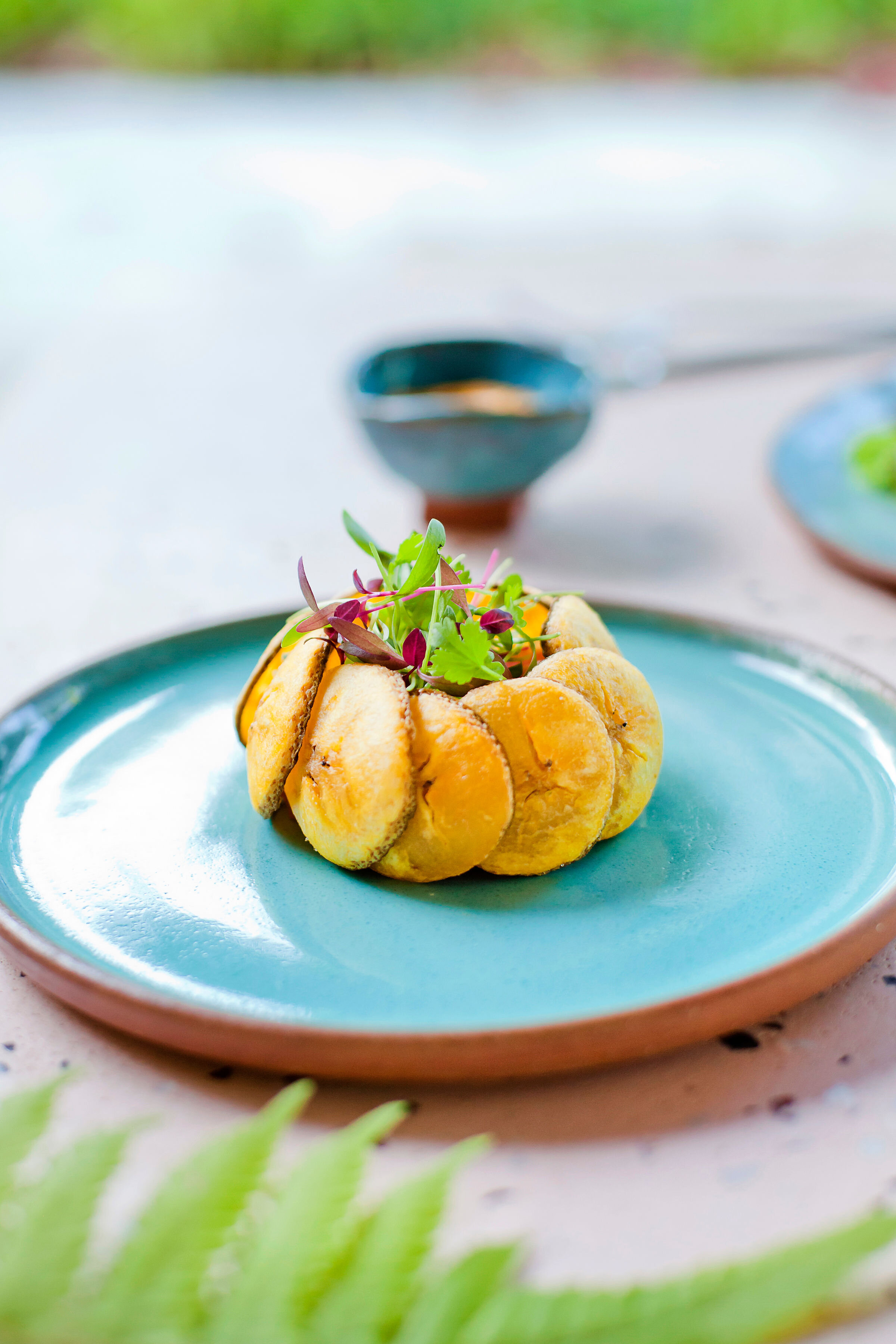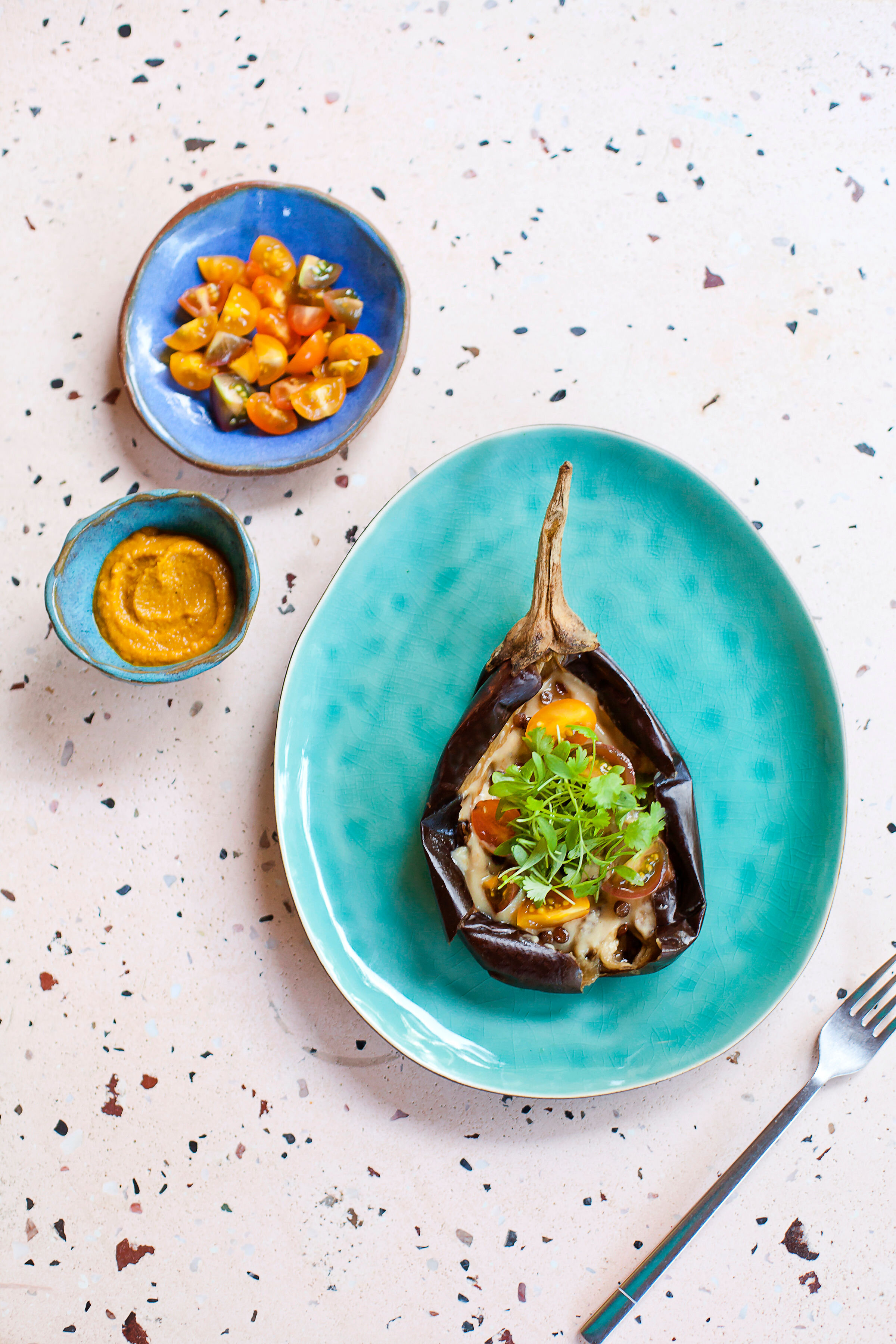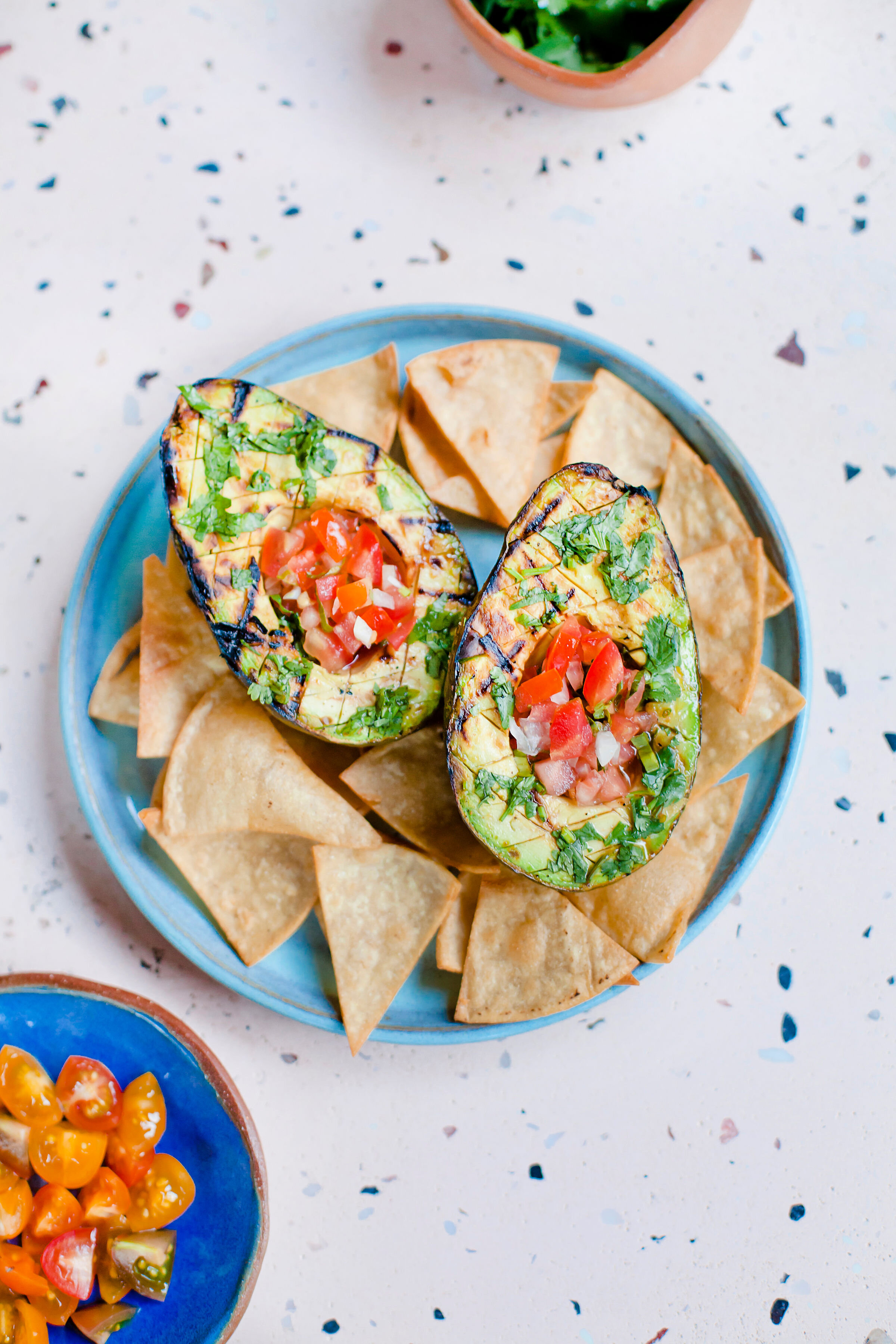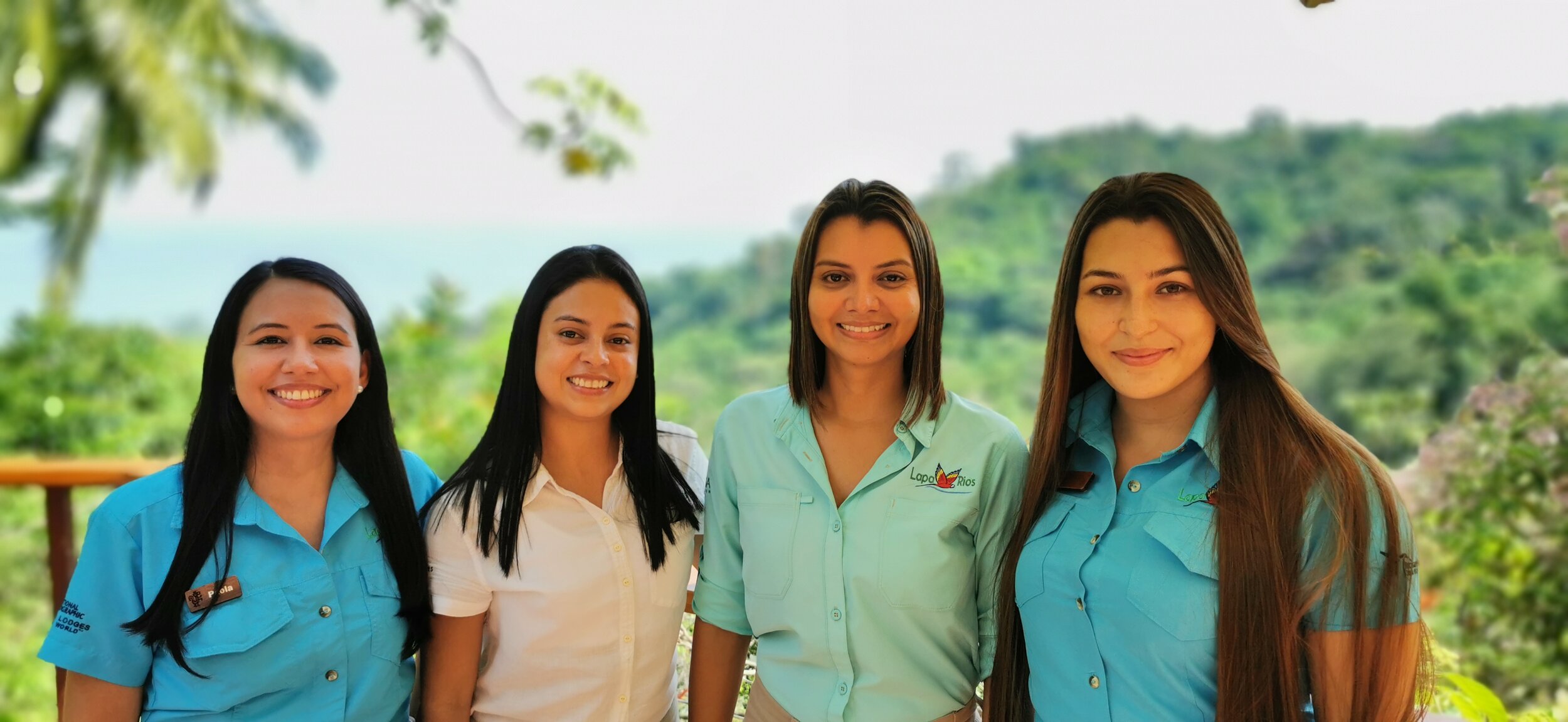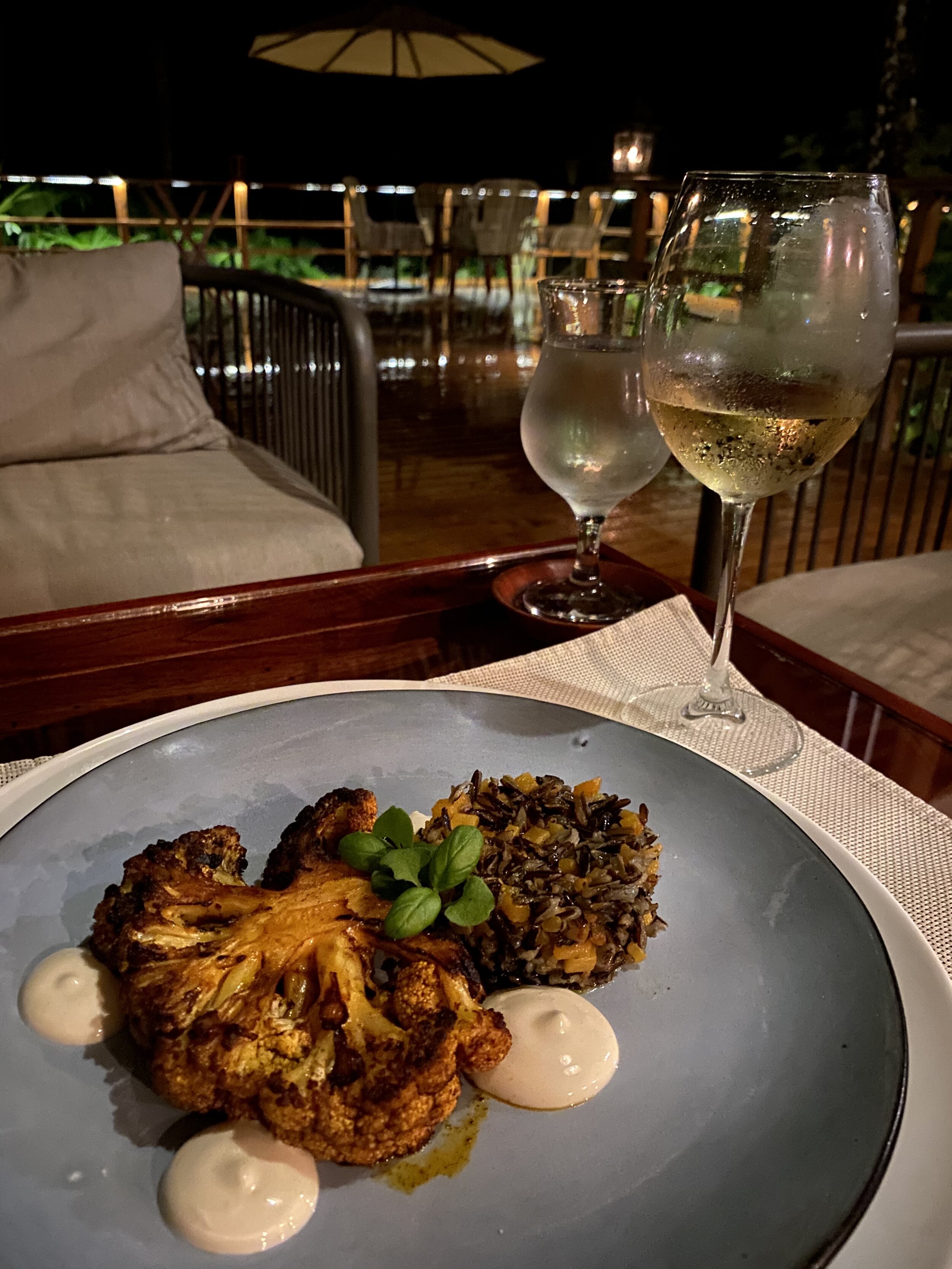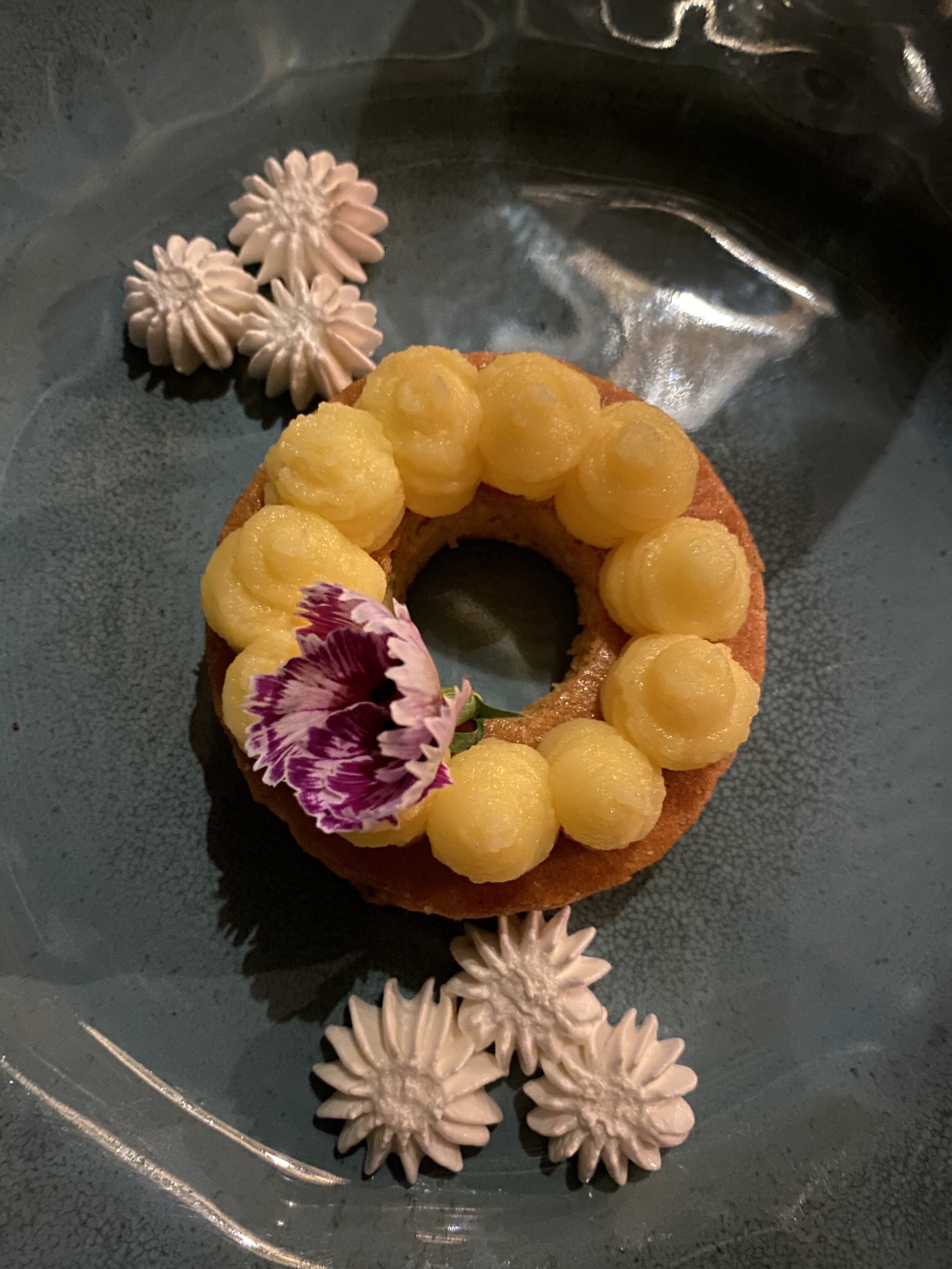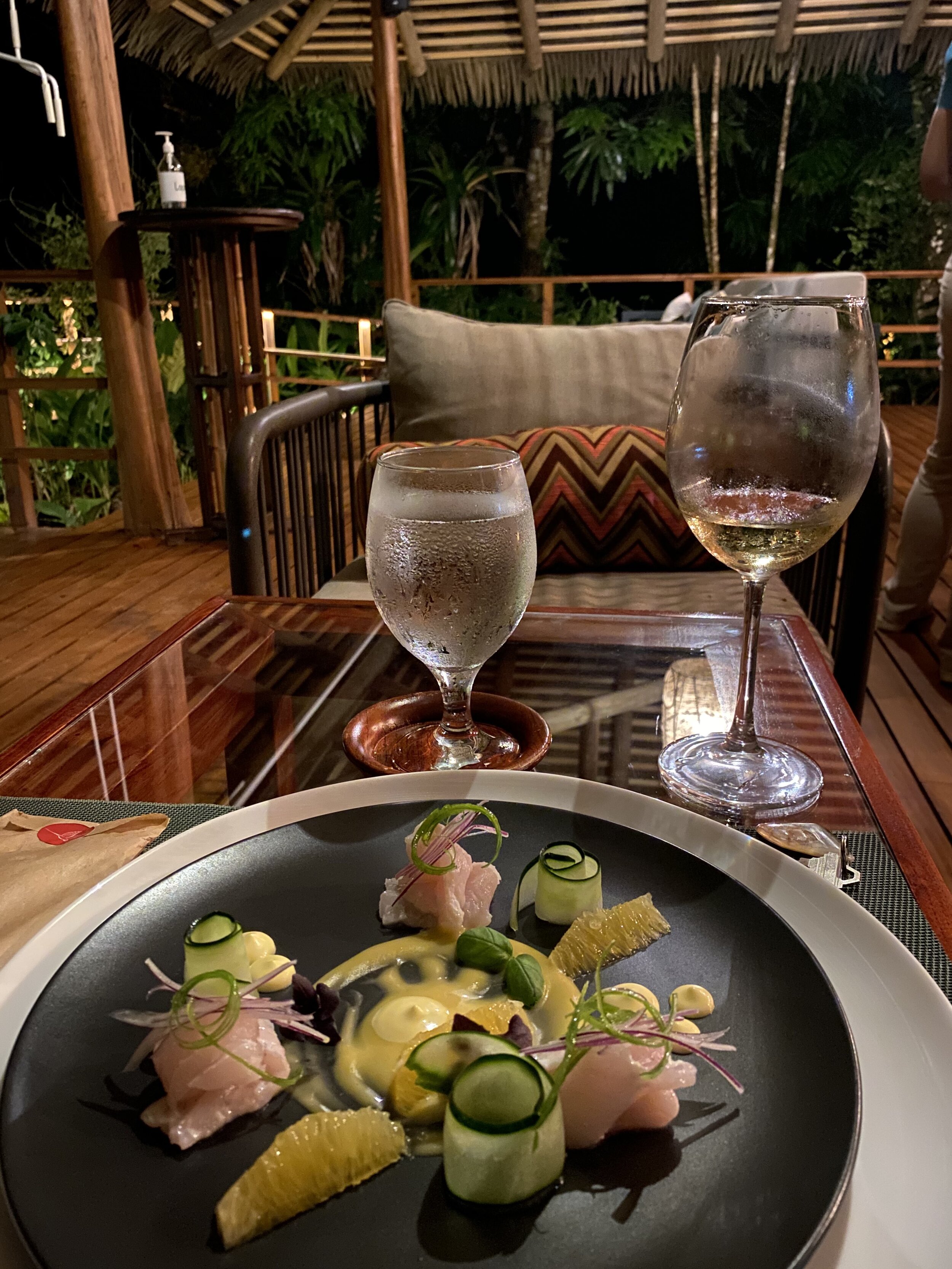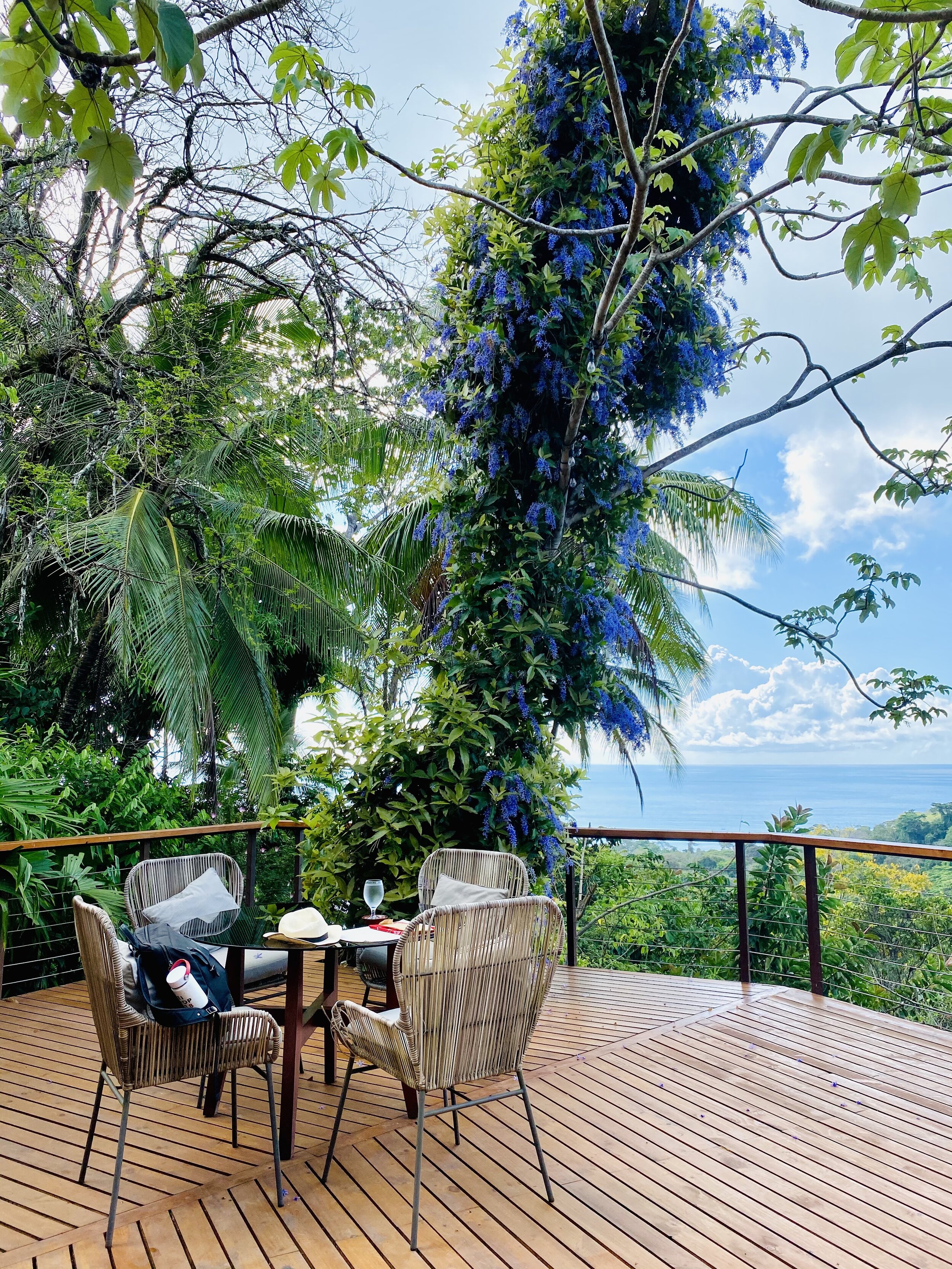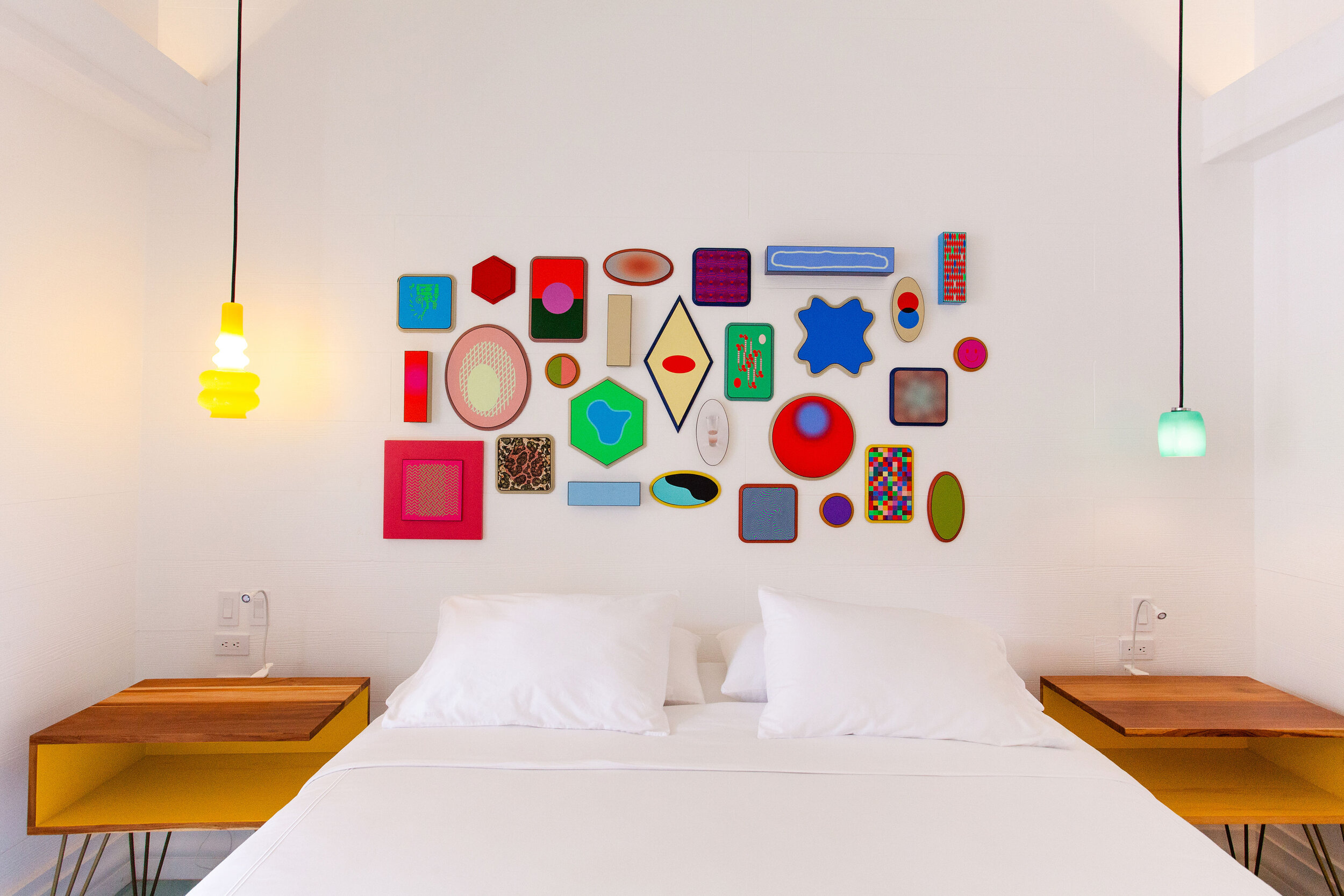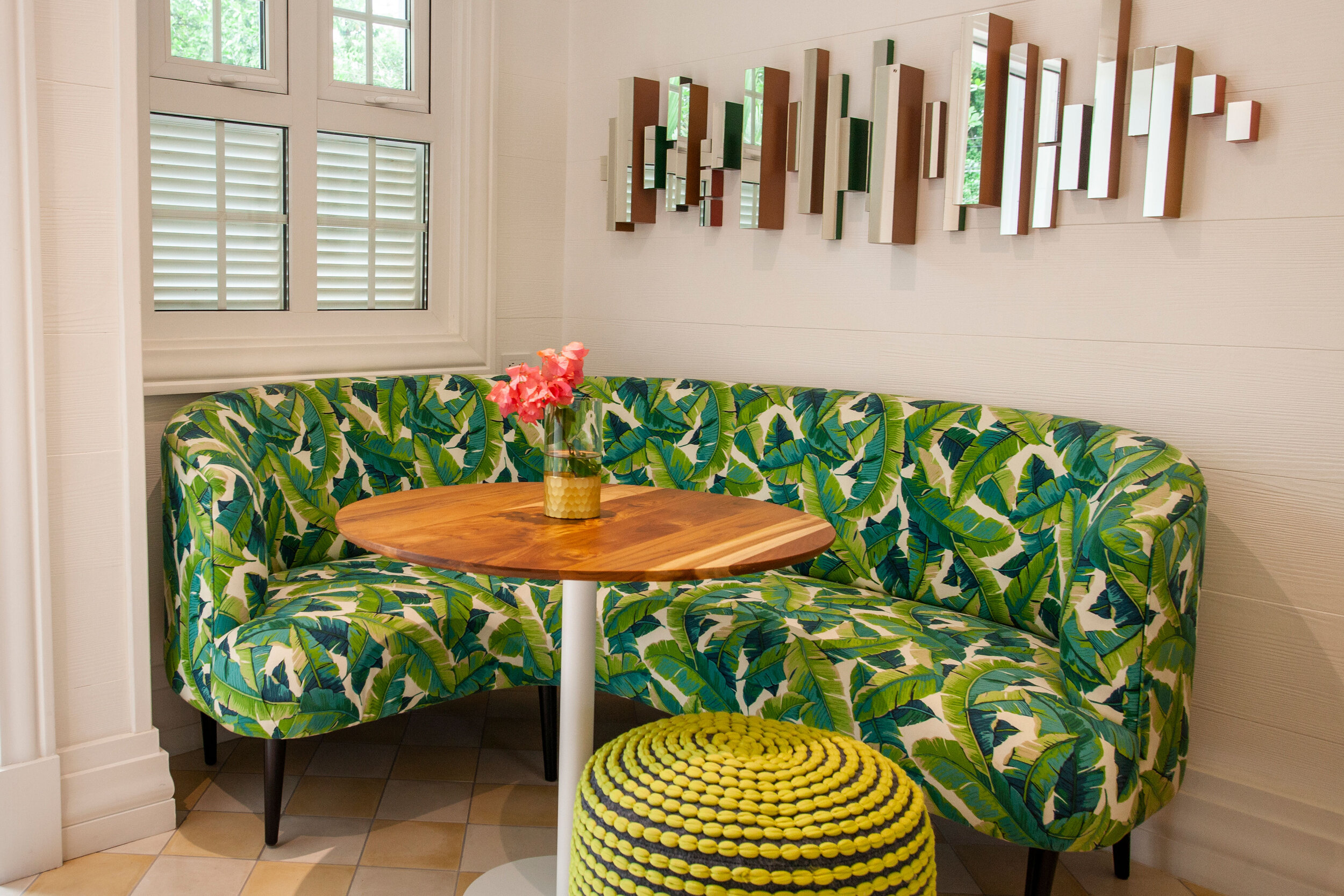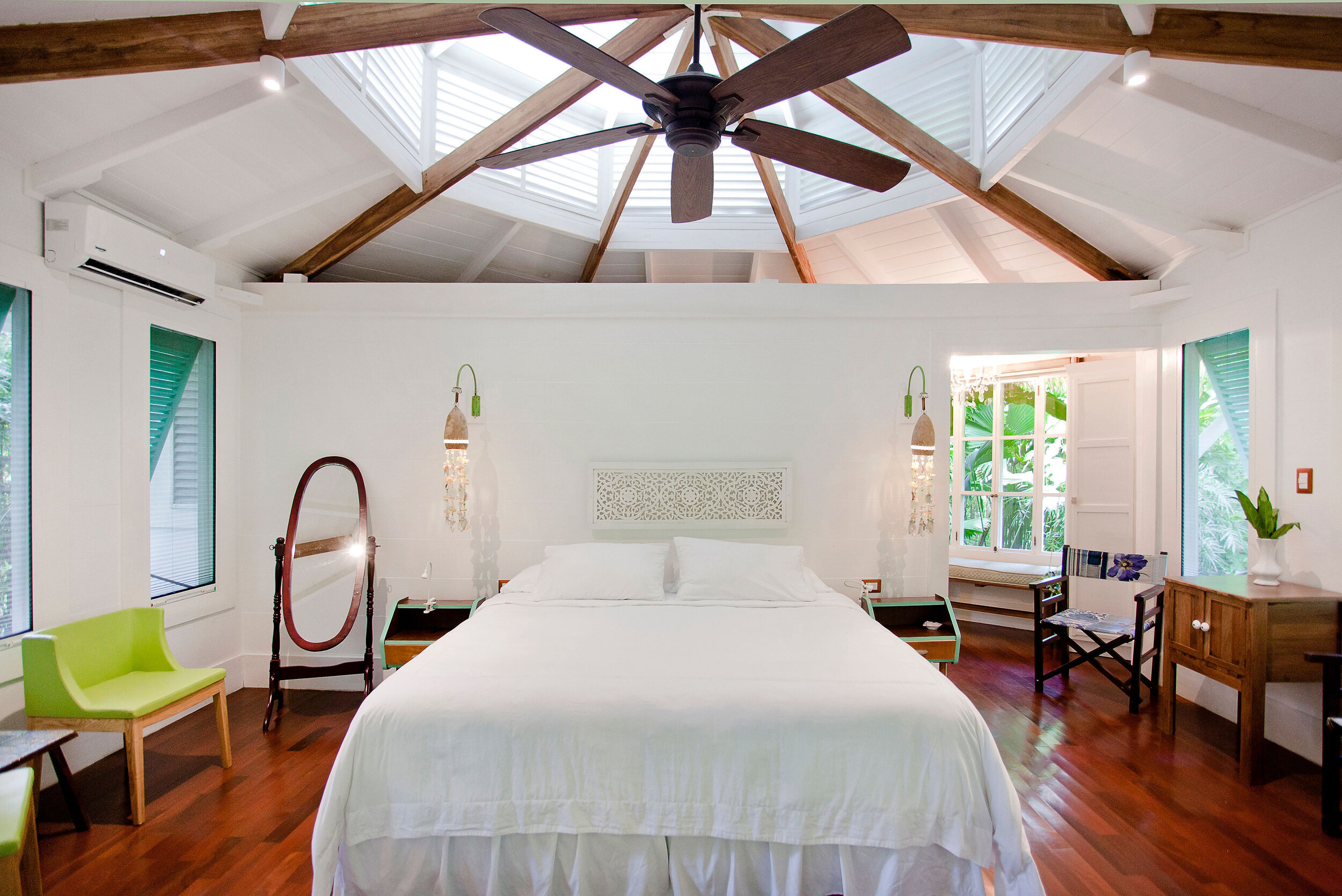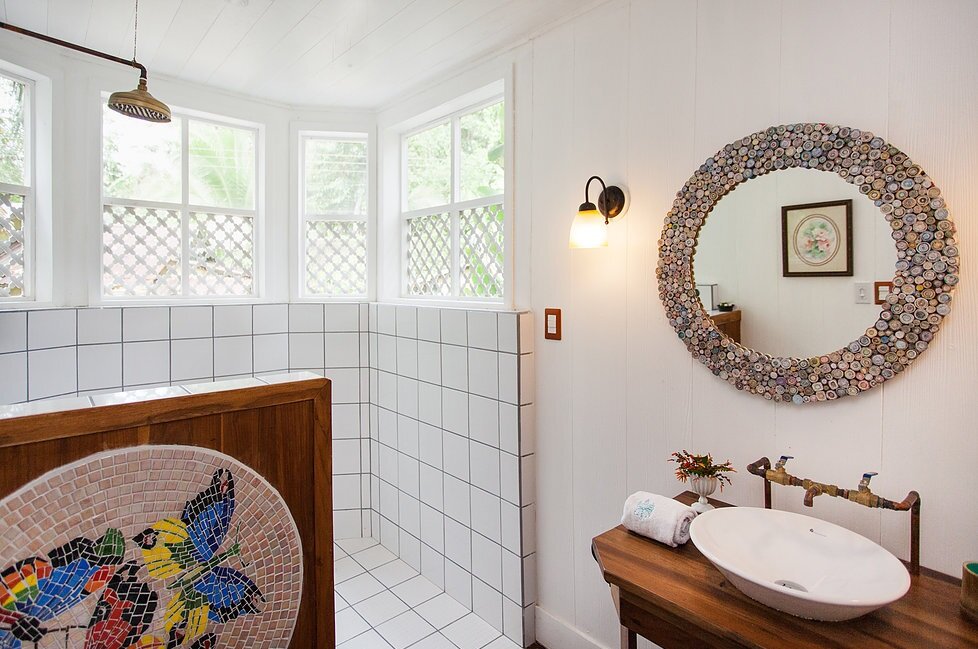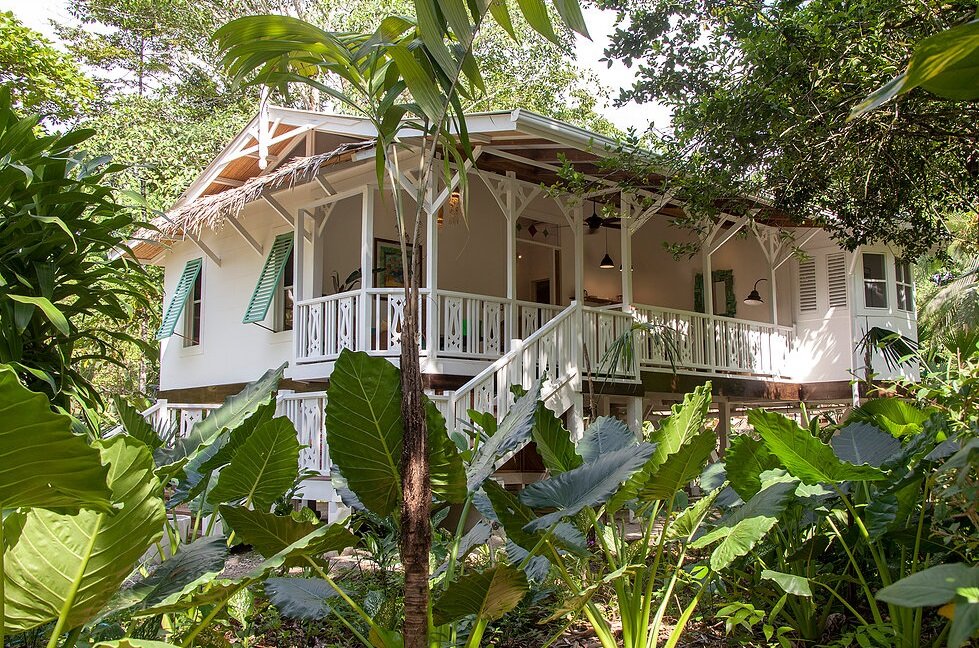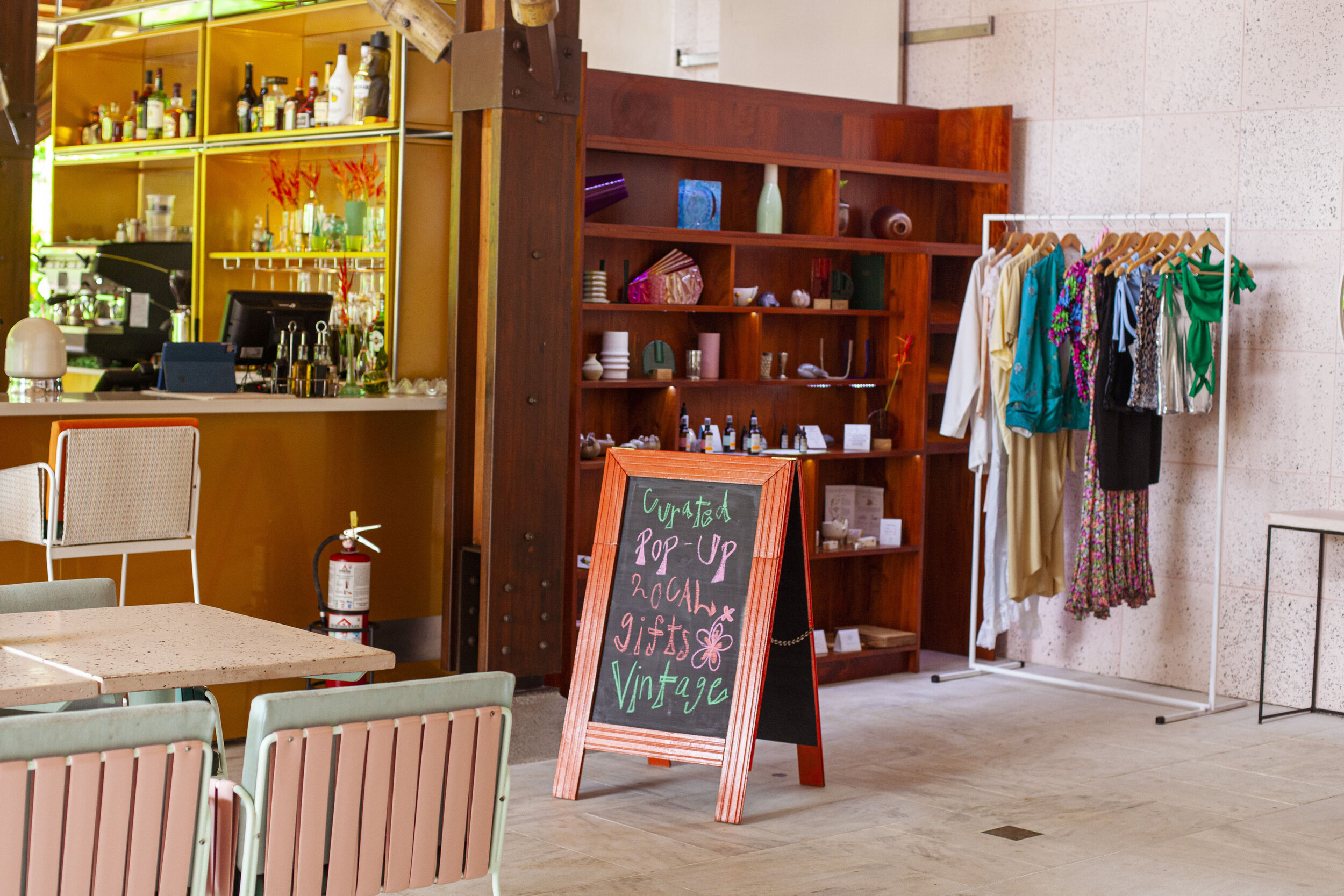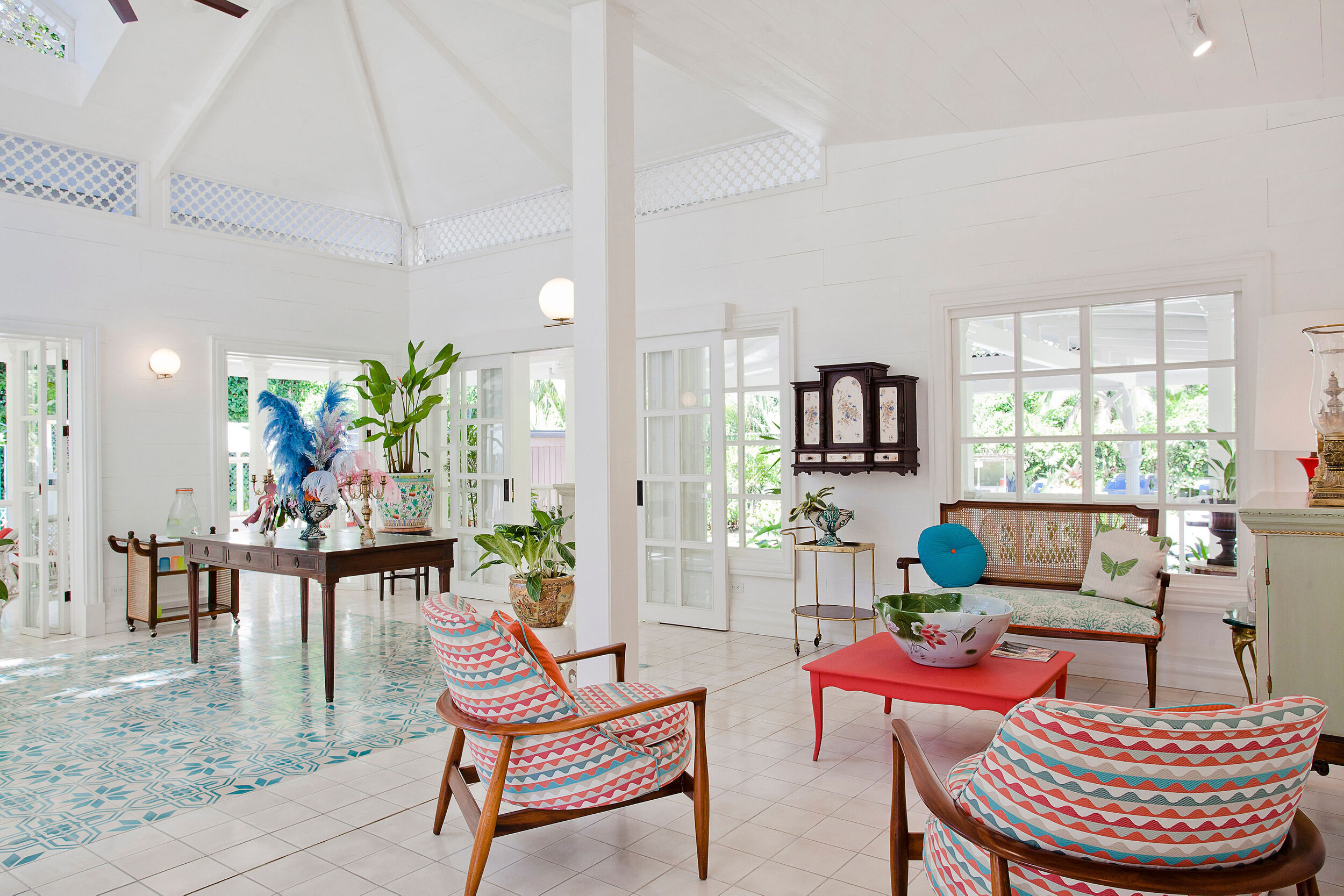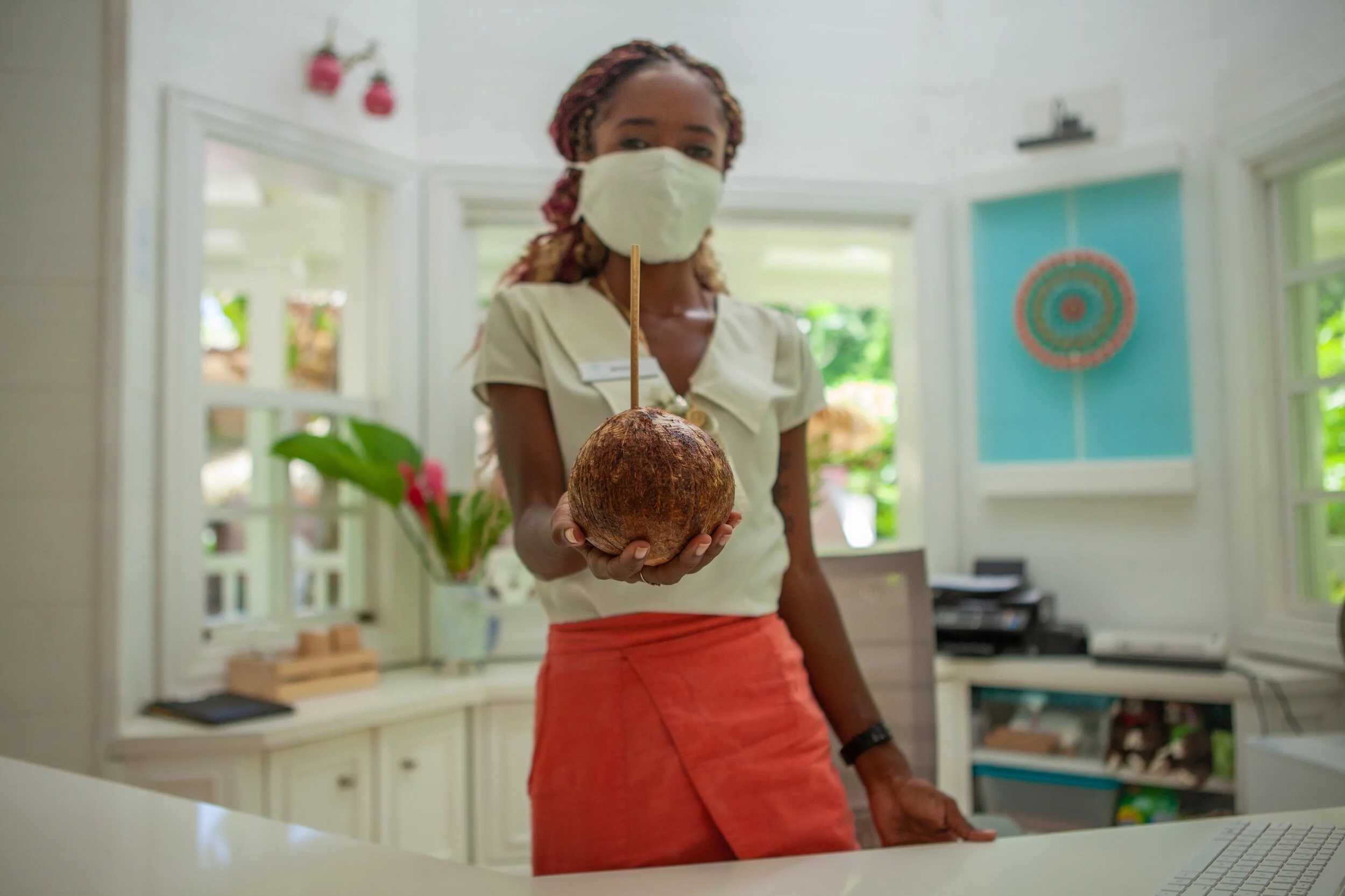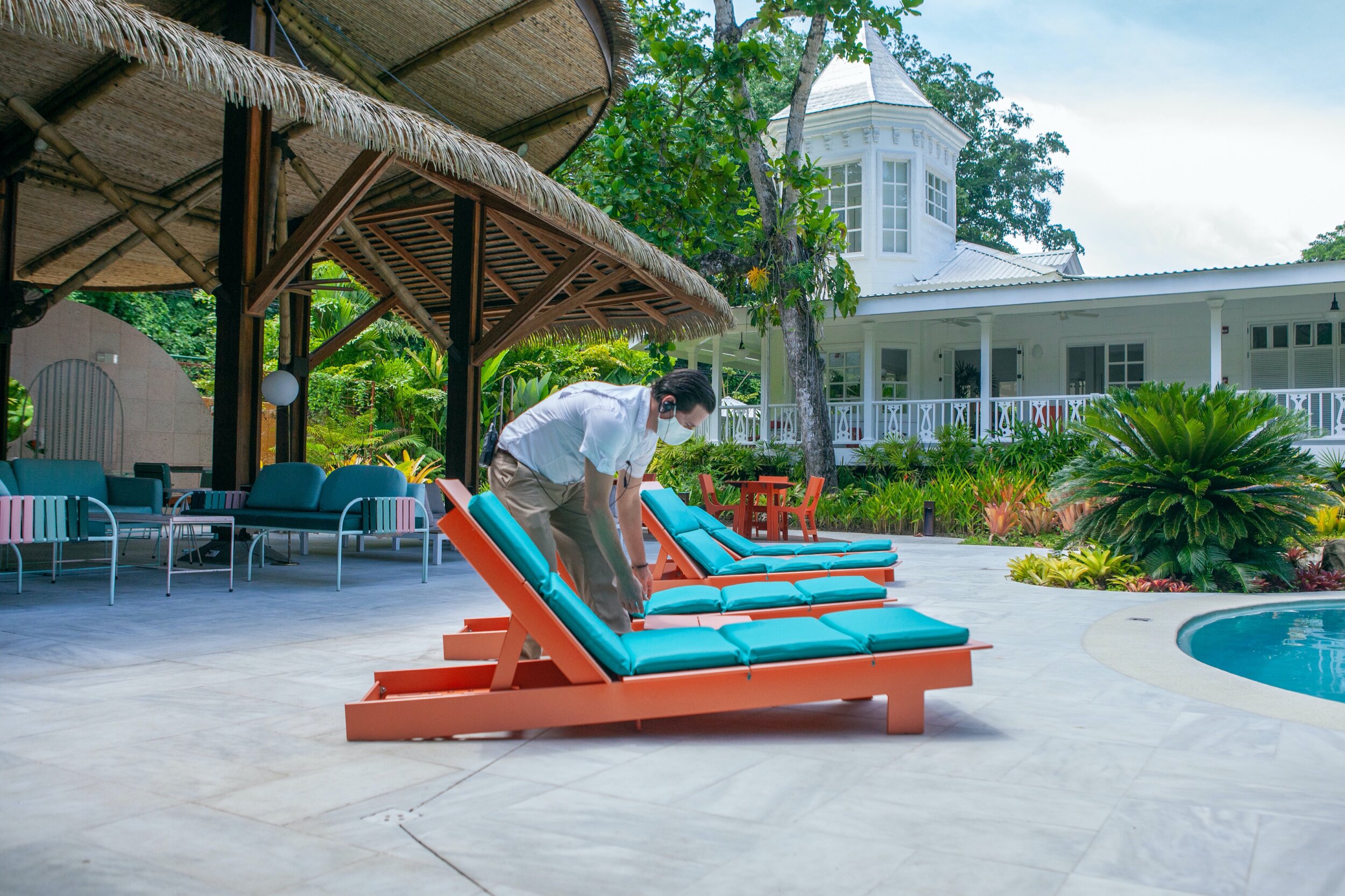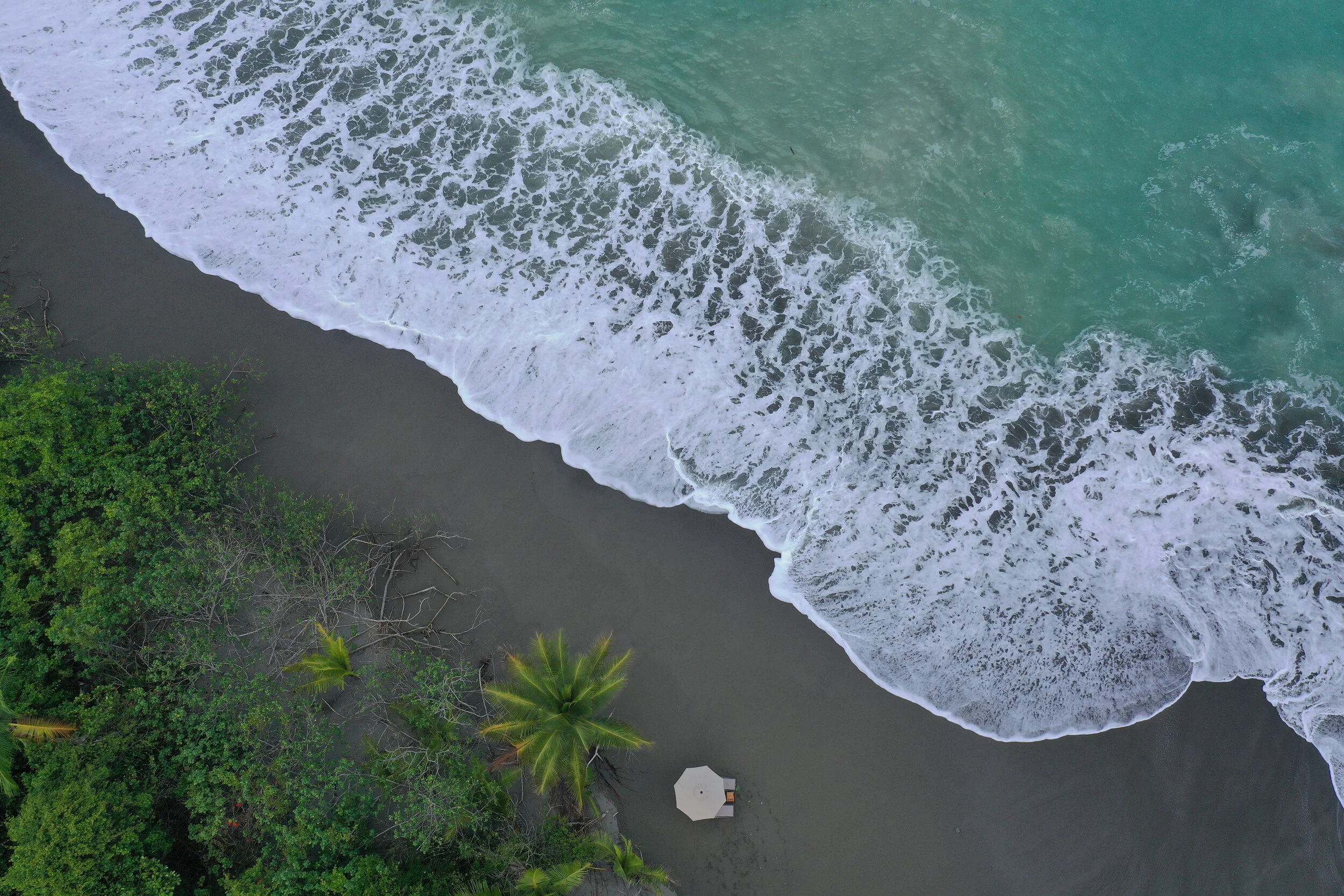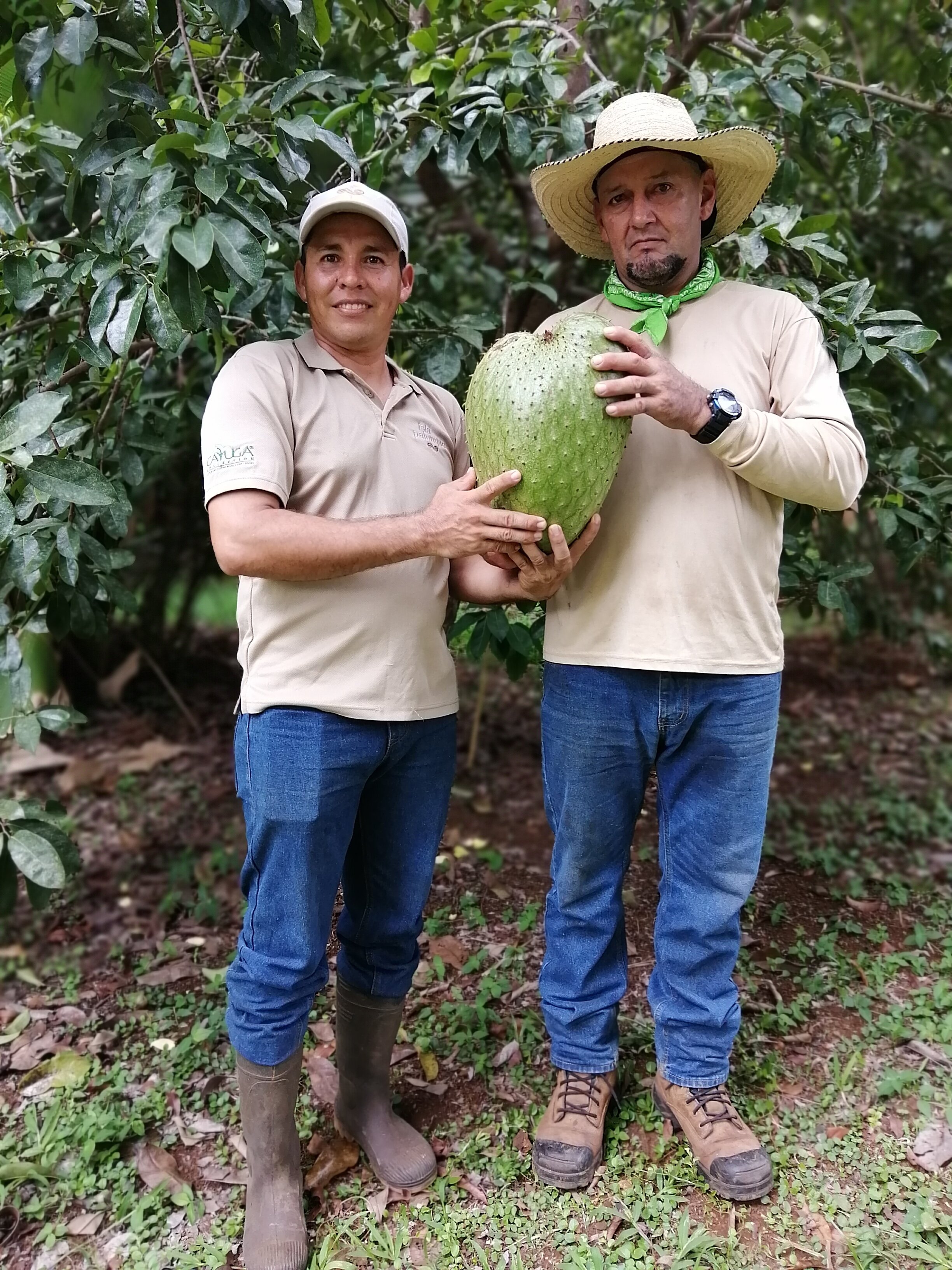Updates from Hotel Aguas Claras
Introducing Bungalow KuaKua, a new menu at Papaya Restaurant and local treasures at Libélula Giftshop
Updates from Hotel Aguas Claras
The prettiest hotel on Costa Rica’s Caribbean Coast just keeps getting better. Hotel Aguas Claras recently unveiled a new studio bungalow (KuaKua), a restaurant menu restyled to bring more creative Caribbean flair and Libélula Giftshop, where guests can browse artisanal Costa Rican brands plus handcrafted art and jewelry from local makers.
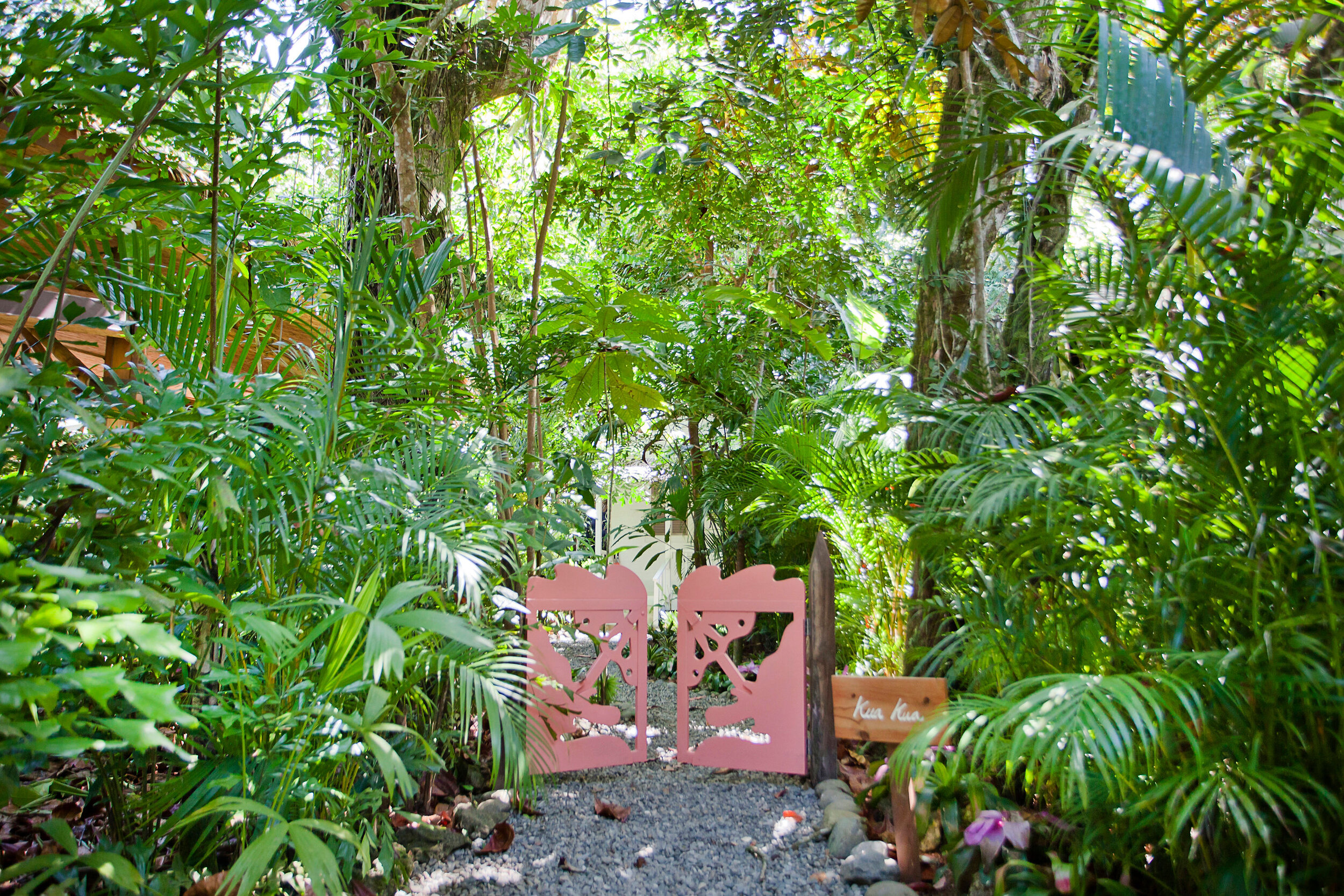
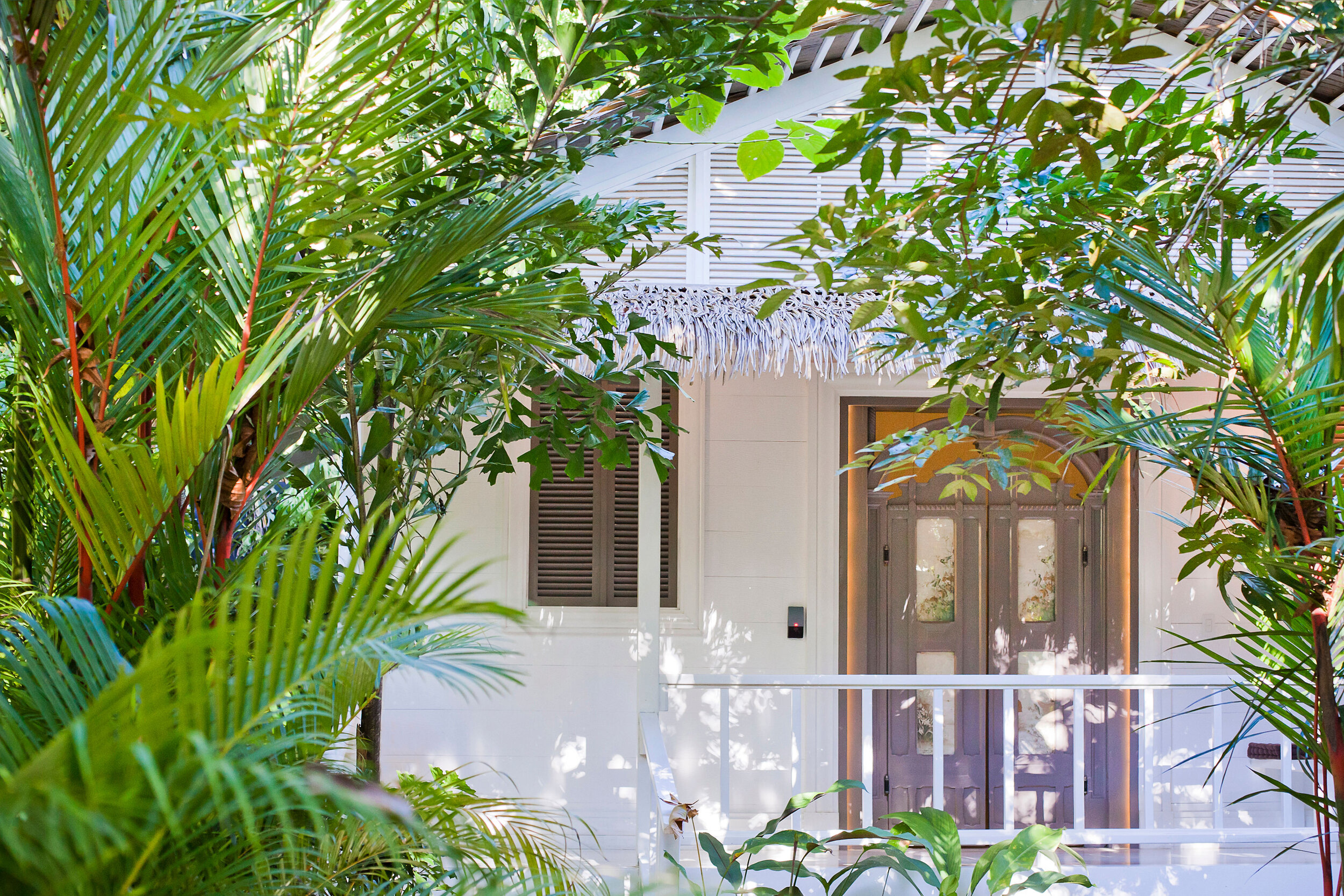
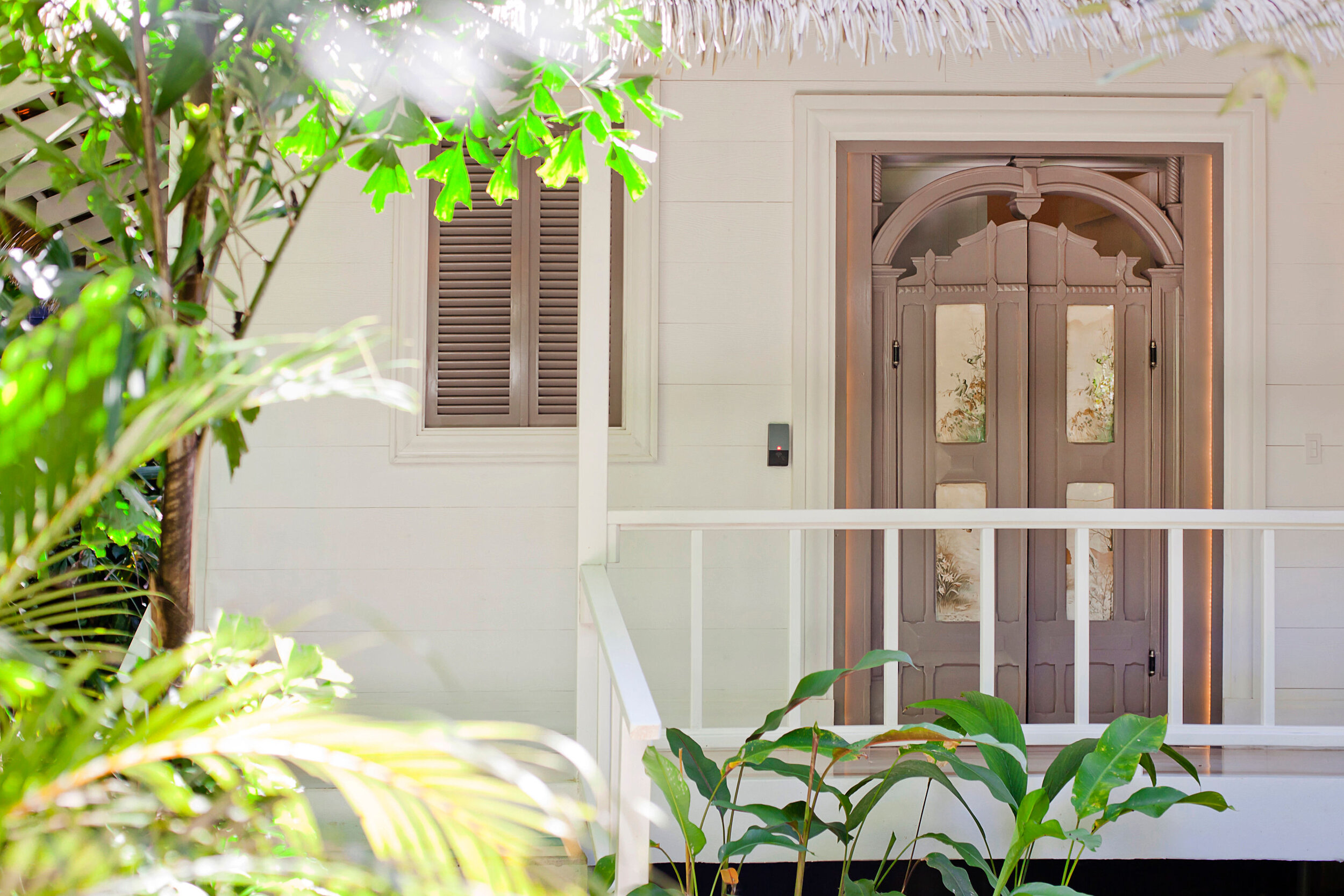

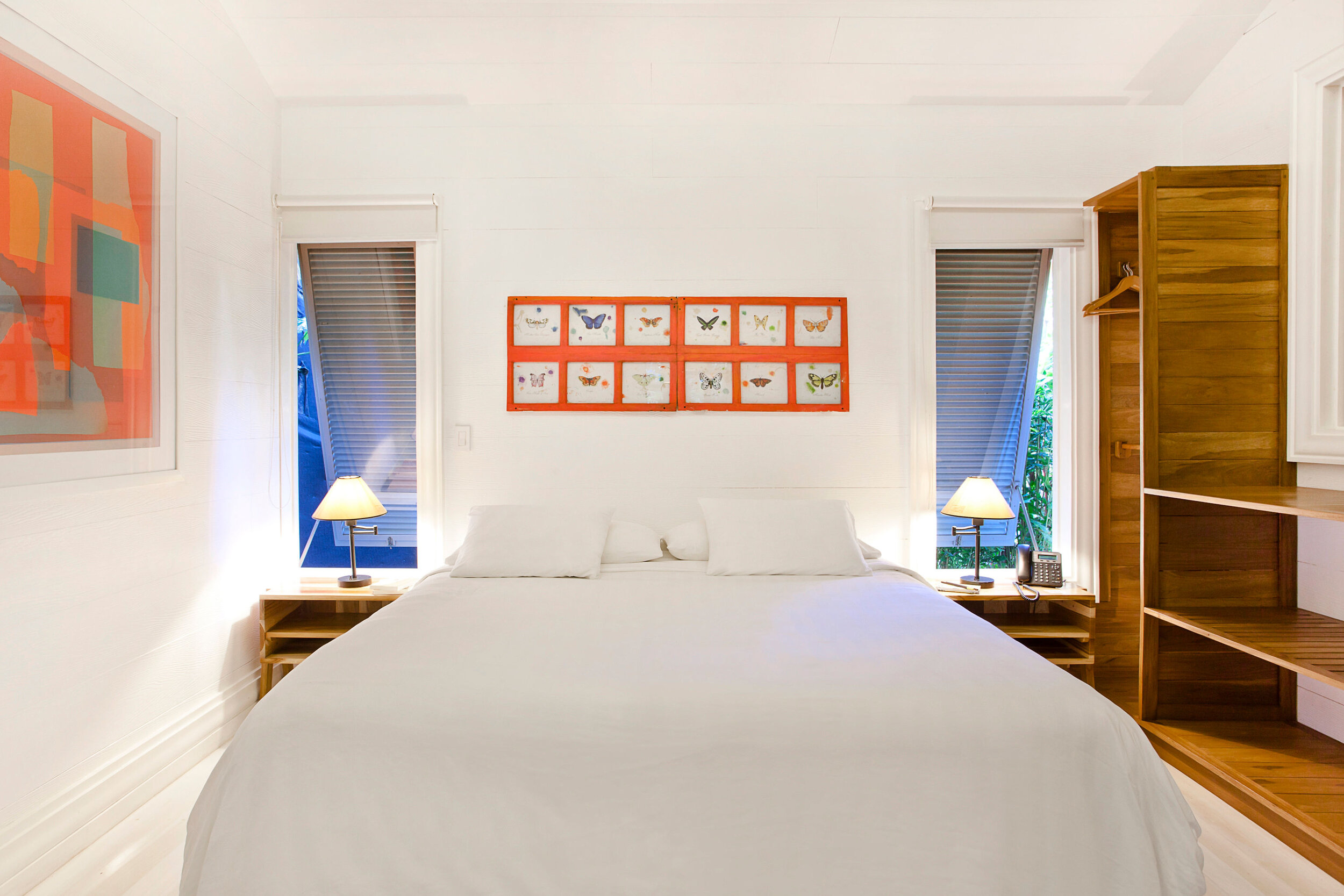

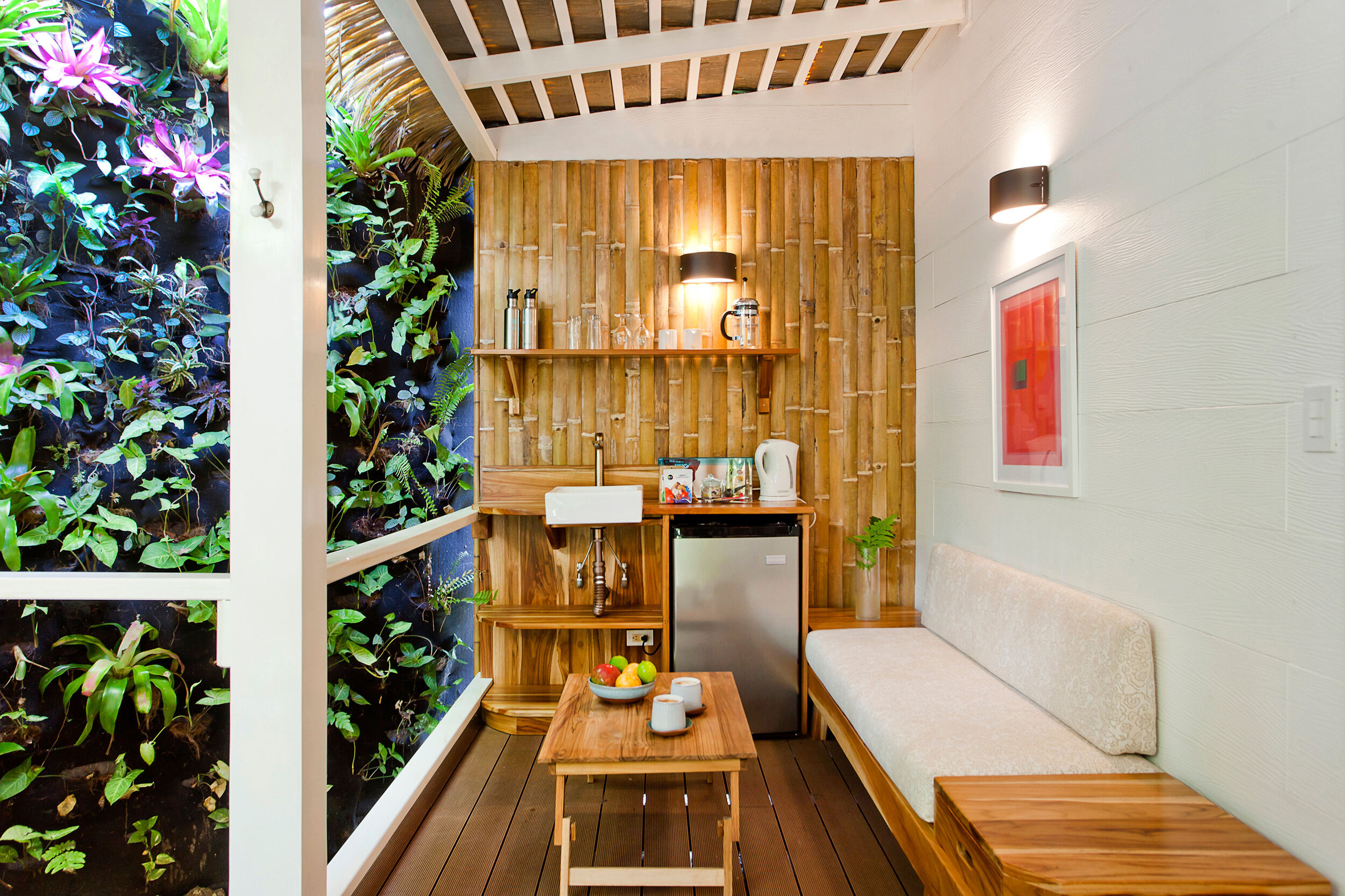

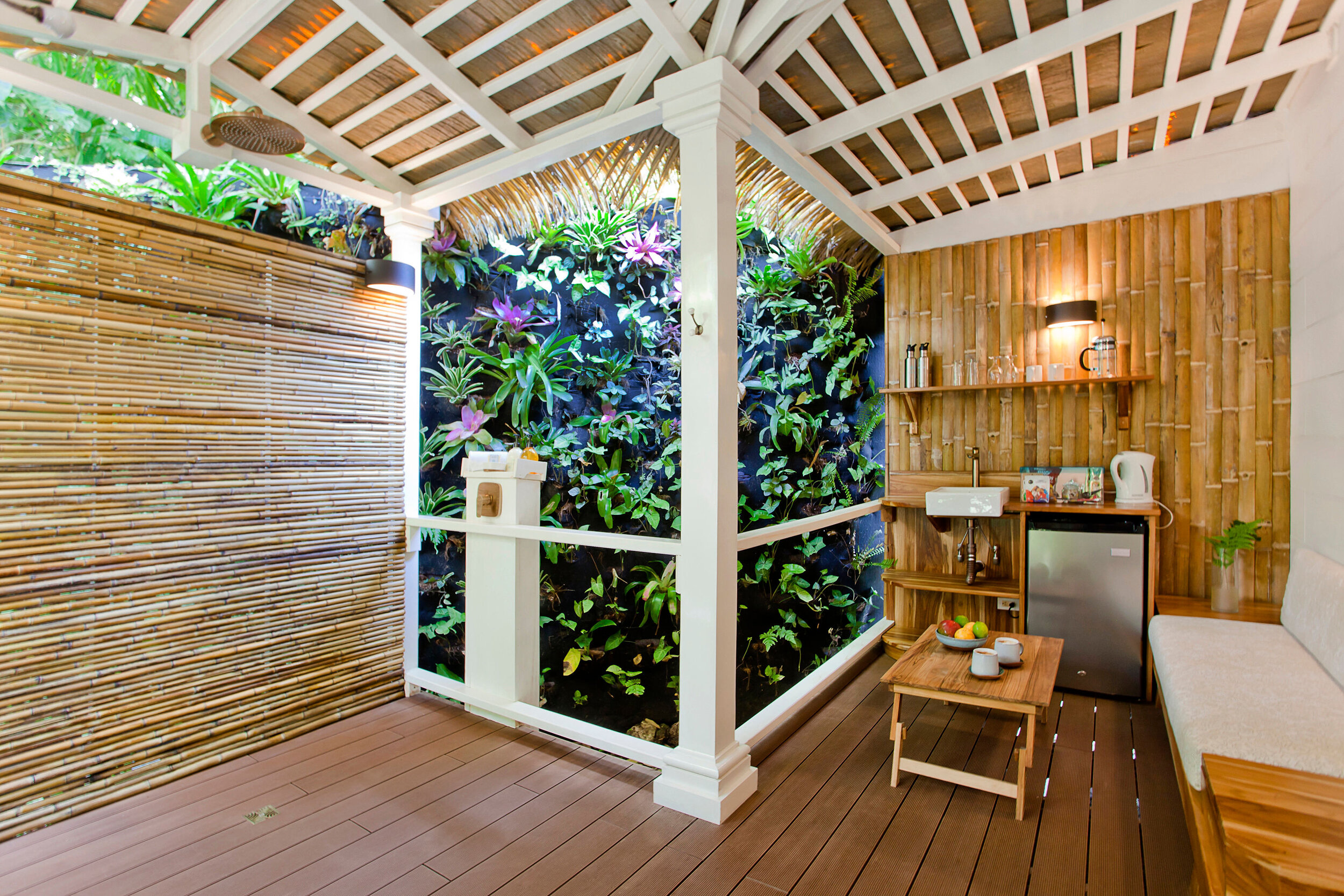
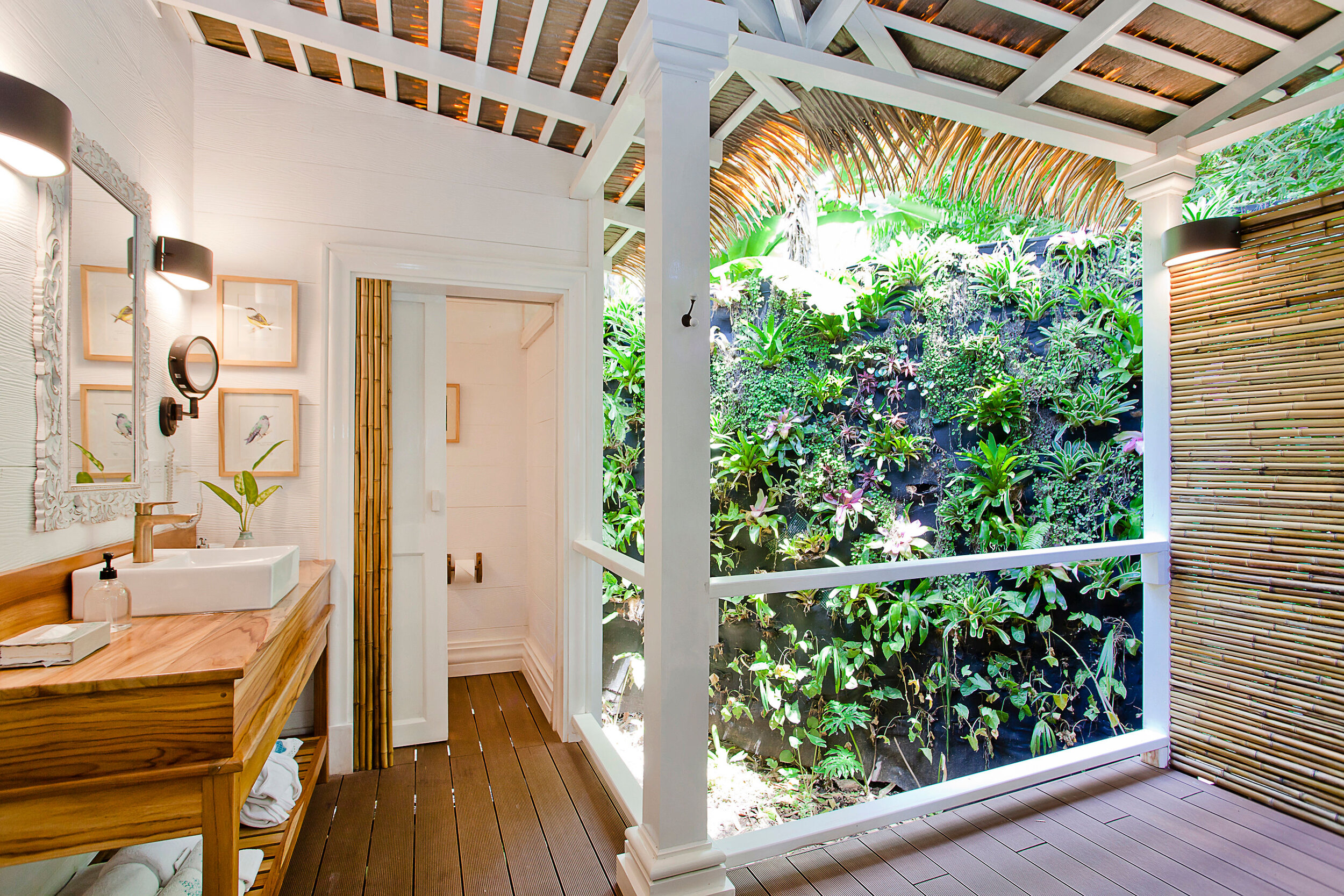
KuaKua Bungalow
Named after “Butterfly” in Bri-Bri (the indigenous language in this part of Costa Rica ) Bungalow KuaKua is a hip, studio-style bungalow with approximately 50 sq.m (540 sq.ft) of private living space with a large, indoor studio space (with AC), two covered verandahs, an outdoor shower, kitchenette and private tropical gardens. Recommended for couples, it can also accommodate families who prefer to all share one room over the Two-Bedroom Bungalow options. (Hotel Aguas Claras welcomes children over 8 years old.)
Tucked back privately among lush gardens, a unique feature of Bungalow KuaKua is the outdoor shower, surrounded by living walls of orchids and bromeliads. The plantings are new and should reach their lush fullness by next season.
Bungalow KuaKua was designed by Hotel Aguas Claras co-owner Elena Rohrmoser and has a distinctively young & bohemian vibe, with white walls and pops of color, similar in palette to the Pavlova Suites. We like it for honeymooners or even single travelers, especially digital nomads who need more work space.
KuaKua Green season rates from $390/night + tax. Download High Resolution photos HERE
New Menu at Papaya Restaurant
Working with Chef Andres Morataya (who has developed the menus at Jicaro Island Lodge, Isla Palenque and more) the culinary team at Hotel Aguas Claras is bringing Caribbean flavors to the forefront of the recently redesigned menu. Expect playful presentations and bold flavors that honor the rich cultural heritage of this slice of Costa Rica, drawing influence from indigenous, West African, Caribbean and Chinese culinary traditions.
Check out the NEW MENU HERE. For lunch, happy hour & small bites, visit the DA LIME BEACH CLUB, part of Hotel Aguas Claras.
Libélula Giftshop
Just down from the main lobby, through the French Doors next to the little neon sign in the shape of a dragonfly is Libélula Giftshop. Here guests will find a curated collection of locally made soaps, candles, jewelry, body products and resort wear as well as vintage fashion from owner Elena’s extensive collection. Artwork from local makers is featured also featured, including watercolor postcards portraying scenes from Hotel Aguas Claras and Puerto Viejo. It’s the perfect place to discover a unique memento of your stay while also supporting the local creative community that thrives in Puerto Viejo.






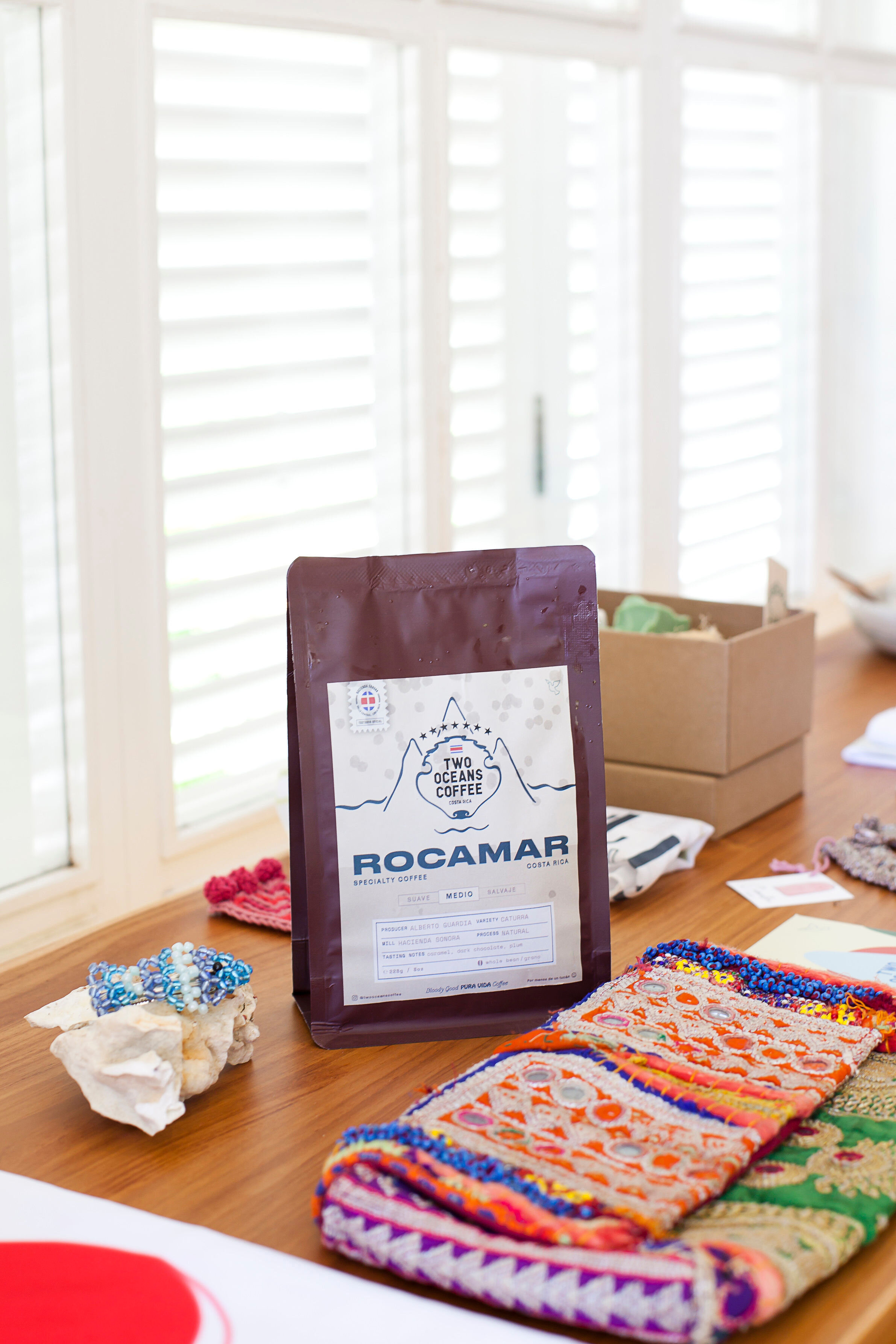

Questions about Hotel Aguas Claras? Contact Kirsten (kirsten@clarkkotula.com) or book through your preferred sales channel. You can contact the hotel directly at travel@hotelaguasclaras.com
Costa Rica Trip Report
What makes Costa Rica an ideal destination for your first Covid-era international trip? Kirsten shares some thoughts & notes from her recent travels in February.
Costa Rica Trip Report
Friends, I have a confession to make. I’ve been a traveler for nearly two decades now, but for the first ten or so years that I spent exploring countries and cultures around the globe, I didn’t give Costa Rica much thought. It seemed too tame, too easy, everyone was doing it. Not a priority. I’d get there eventually. Myanmar, Northern Brazil, Venezuela, Japan, Southern Africa - these were the more exotic, harder to access places that called to me first and filled my passports with their stamps and visas. Costa Rica could wait.
Clearly I have been converted by the gospel of Pura Vida and have been a devoted fan of Costa Rica ever since my first visit to the country (and more specifically the Osa Peninsula which is my happy place.) But after returning last month to dip a toe back into the waters of international travel, it dawned on me that Costa Rica’s reputation as a perfect “starter destination” and gateway country for international travel to more ambitious and farther flung locations make it THE ideal candidate for NOW as travelers cautiously consider a return to international explorations beyond a weekend at a gated resort in Cabo.
Happiness is a horseback ride at sunset in Monteverde
Costa Rica is safe, so very clean, a short nonstop flight from many airports throughout North America and extremely welcoming. Public health has always been prioritized (you can drink straight from the faucet almost anywhere in the country) and embracing a lifestyle that enables holistic wellbeing is literally the official national mantra. And, in the same understated, humble way that little Costa Rica has led the way in low-impact, high-return, sustainable nature-based tourism and doing things differently (like abolishing the army and investing instead in education) they’ve reopened with a unique but effective approach; gradually eliminating the friction points like PCR testing and mandatory quarantines on arrival* to jumpstart the country’s tourism industry while still maintaining common sense & science-based protocols (mask wearing indoors, social distancing) to reduce the risk of transmission. The data speaks for itself; opening up Costa Rica to travelers has shown so far to be safe and a great benefit both for locals and for visitors.
Ten days in the country was just the shot of sanity and sunshine I needed to feel slightly like myself again and reconnect to my purpose & passions. Costa Rica, with easy access and all the nature is the antidote to pandemic-induced depression - I can’t recommend it enough, especially if you’ve overlooked the country in the past.
Following are the details of my own trip in February 2021 and recommendations for you and your travelers, as someone who has been to the country eight times. Information is accurate at the time of writing but like everything these days, could very well change. Make sure to check the Costa Rican Tourism Board website as well as those of your own country of origin for the latest information prior to travel.
Requirements for Travel:
I’ve read about the numerous hoops that passionate travelers have jumped through to reach various destinations over the past few months. A complex evolving series of schedule changes, testing requirements, paperwork and certificates - likely well worth the hassle to access certain places right now. But that amount of effort and uncertainty may not appeal to everyone.
Traveling to Costa Rica was easy-breezy. Travelers must purchase insurance that meets three requirements: 1.) the policy must be effective for the entire time in-country 2.) It must offer at least $50,000 in coverage for Covid-19 related medical expenses and 3.) it must cover at a minimum $2,000 in extended lodging expenses due to Covid-19 (ie. cost to quarantine if you contract the virus).
#3 is what I get the most questions about as many major international providers (like TravelEx for example) do not expressly meet this condition. So, in addition to whatever larger policy your clients purchase, add on the Sagicor plan available HERE - coverage rates vary and for me at 37 yoa it was about $11/day. Is it a racket? Maybe, but it is easy to purchase and a small price to pay for peace of mind. Or, talk to your DMC about obtaining a letter of exemption from this requirement due to larger comprehensiveness of the coverage. We’ve recently learned this is possible too.
Otherwise travelers must fill out an electronic Health Pass which is available 48 hours prior to their international flight departure. Once completed you’ll receive a QR code via email which must be shown to the airlines prior to boarding your international flight and again at Passport Control upon arrival into the country. While I had printed copies of both my travel insurance and QR code, neither of these were necessary as the electronic version of the QR code was accepted and contained all needed info.
No testing is required to enter Costa Rica but is still encouraged out of respect for the safety and health of the local people. I opted for the rapid antigen test a couple of days prior to flying.
My mid-week flight from LAX to SJO on Alaska was only 25% full but I returned on a Sunday via the same route on a plane that was closer to 80%. If you have the flexibility to travel mid week, you might have an emptier flight.
Health & Safety Protocols In-Country
Mask wearing, temperature scanners and social distancing were all being enforced in SJO and at the adjacent domestic terminal and people were complying without issue. Hand sanitizer and hand washing stations are everywhere. Guides, drivers and staff were all masked, without exception. Generally the check-in experience at each hotel began with hand washing & a temperature check by masked staff though guests were not required to wear masks, unless passing through an enclosed, indoor space.* I don’t know how this is being enforced beyond our properties but as the vast majority of the lodges & hotels that we work with in Costa Rica are open-air with restaurants and spas existing in large, outdoor covered spaces with ample ventilation, mask wearing by guests wasn’t a requirement.
*For the first and last nights of my trip I stayed at the Courtyard Marriott in Alajuela, mostly for the free shuttle and proximity to the airport. All passengers and the driver were masked for the transfer but this was the only hotel I experienced where temperatures were not taken on arrival, luggage was not wiped down and hand washing wasn’t enforced (though sanitizer was available). Staff and guests were all masked at the hotel, which felt good enough for me personally, but something to be aware of for clients who are very nervous about traveling right now. A boutique San Jose property like Finca Rosa Blanca, Casa 41 or Grano de Oro may be a better choice even if the transit time is a bit further.
A nearly empty & well spaced out domestic terminal in San Jose at 7:30 am on Friday, February 28
Travel Through Costa Rica
On my second day it was back to the airport for an early flight to Puerto Jimenez and 4-day stay at Lapa Rios Lodge on the Osa Peninsula. The domestic terminal was super dialed with hand washing, disinfecting foot mats, taking temperatures on entry and blocking seats to enforce social distancing, though it was also virtually empty for my early AM flight.
Sansa, Green and Skyway airlines are again offering multiple nonstop daily options between San Jose and the southern Pacific airstrips in Golfito and Puerto Jimenez (as well as destinations throughout the country) though for groups of 4 or more chartering a small plane to fit your own schedule may make more sense and avoids the need to connect through San Jose when traveling point to point.
Also, do not be afraid of renting a car in Costa Rica. The country is a joy to drive through - river crossings or waiting for horses to pass on a road being part of the fun! A high clearance 4WD vehicle will get you just about anywhere and gives you flexibility to poke around on your own, searching out remote surf breaks and roadside sodas like a local. I get that some people prefer to be driven as driving stresses them out, but if your clients are interested, don’t dissuade them. Even the notoriously bad roads of the Nicoya Peninsula can be fun if approached with the right attitude. Rental car companies will privately deliver and pick up vehicles just about anywhere for a nominal fee.
At the hotels themselves, there was very much a sense of normalcy, of business as usual just with less guests than a typical February and the additional protocols mentioned above. Wellness centers, pools, bars and restaurants are all open with generous table spacing, though in some cases the hours may be reduced (like at Arenas Del Mar where breakfast and dinner are only being served at El Mirador though lunch service is offered at both El Mirador and Playitas Beach). Group yoga & fitness classes are on hold for the time being but mats and hand weights can be brought to your room to exercise in private. Most excursions are available, though there is an effort being made to arrange private tours exclusively whenever possible and school visits are not available at the moment. Daily visitor numbers at national parks are also reduced to prevent over crowding so make sure to arrange these excursions + permits in advance through the hotel or DMC. By and large the experience you can have as a traveler in Costa Rica is currently as good if not better than it was prior to the pandemic. The hotels are currently operating at around 30-55% average occupancy each month though Fridays & Saturdays do tend to be a bit busier with a robust local market in San Jose looking to escape the city for the weekend.
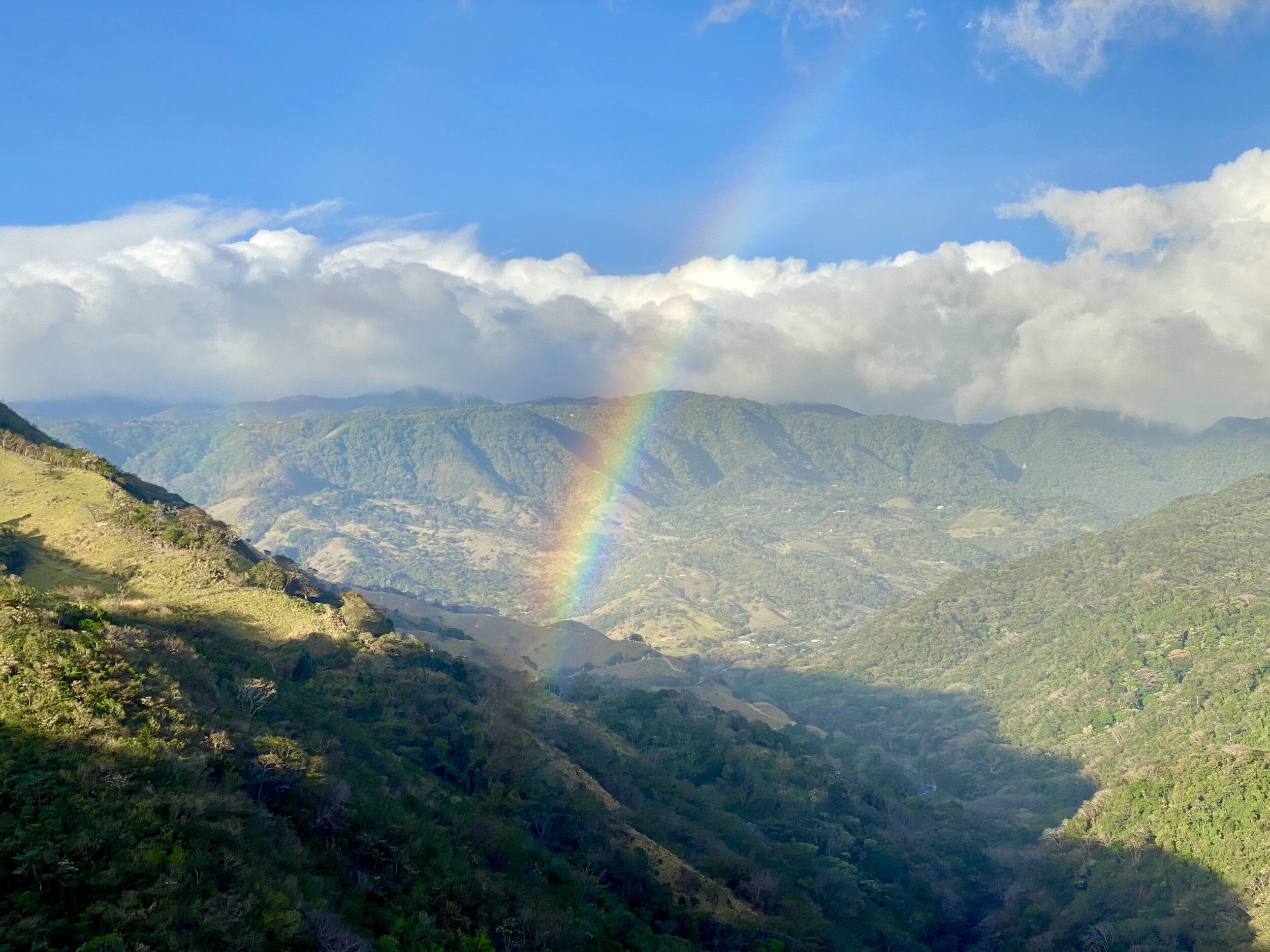
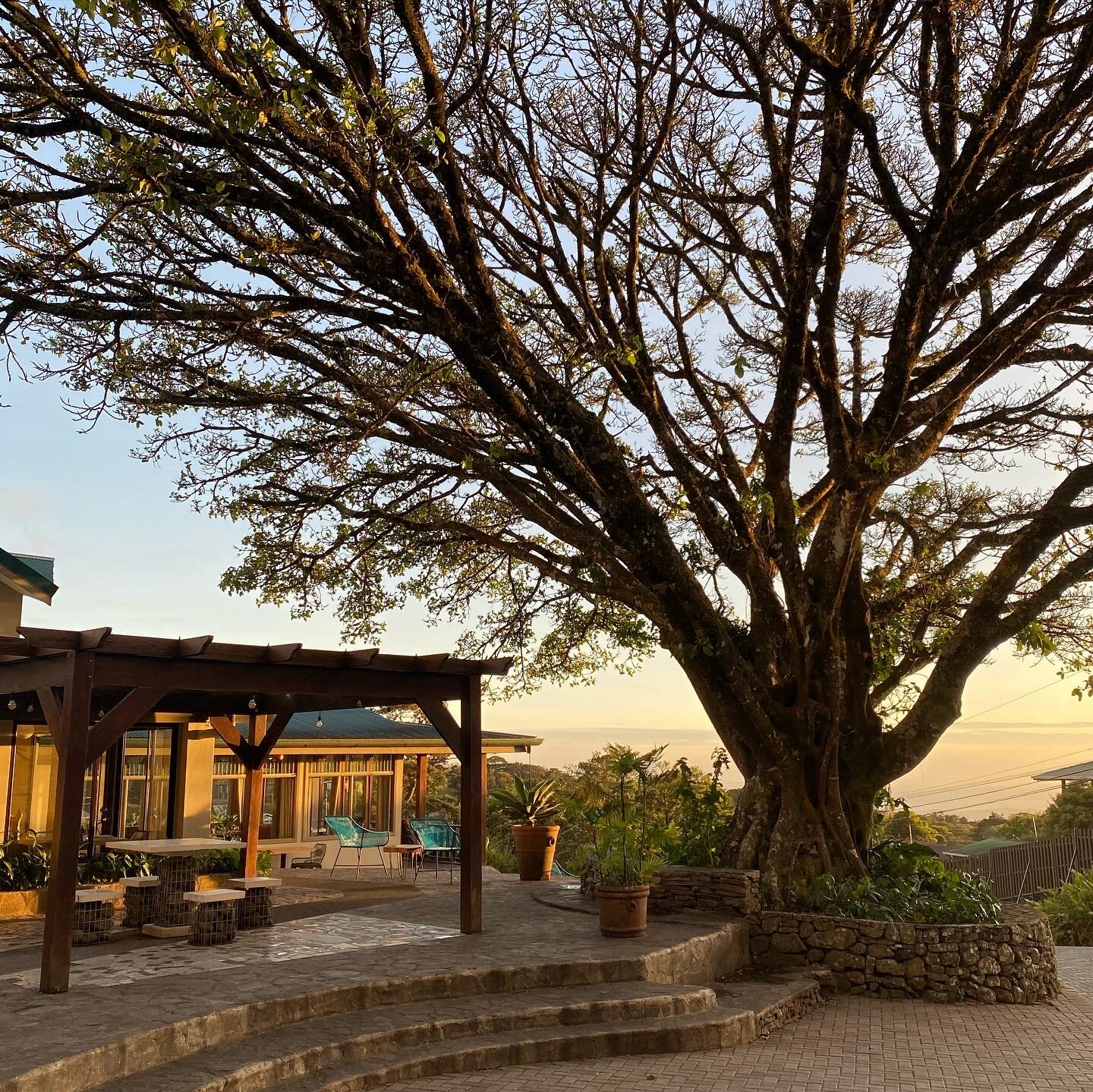
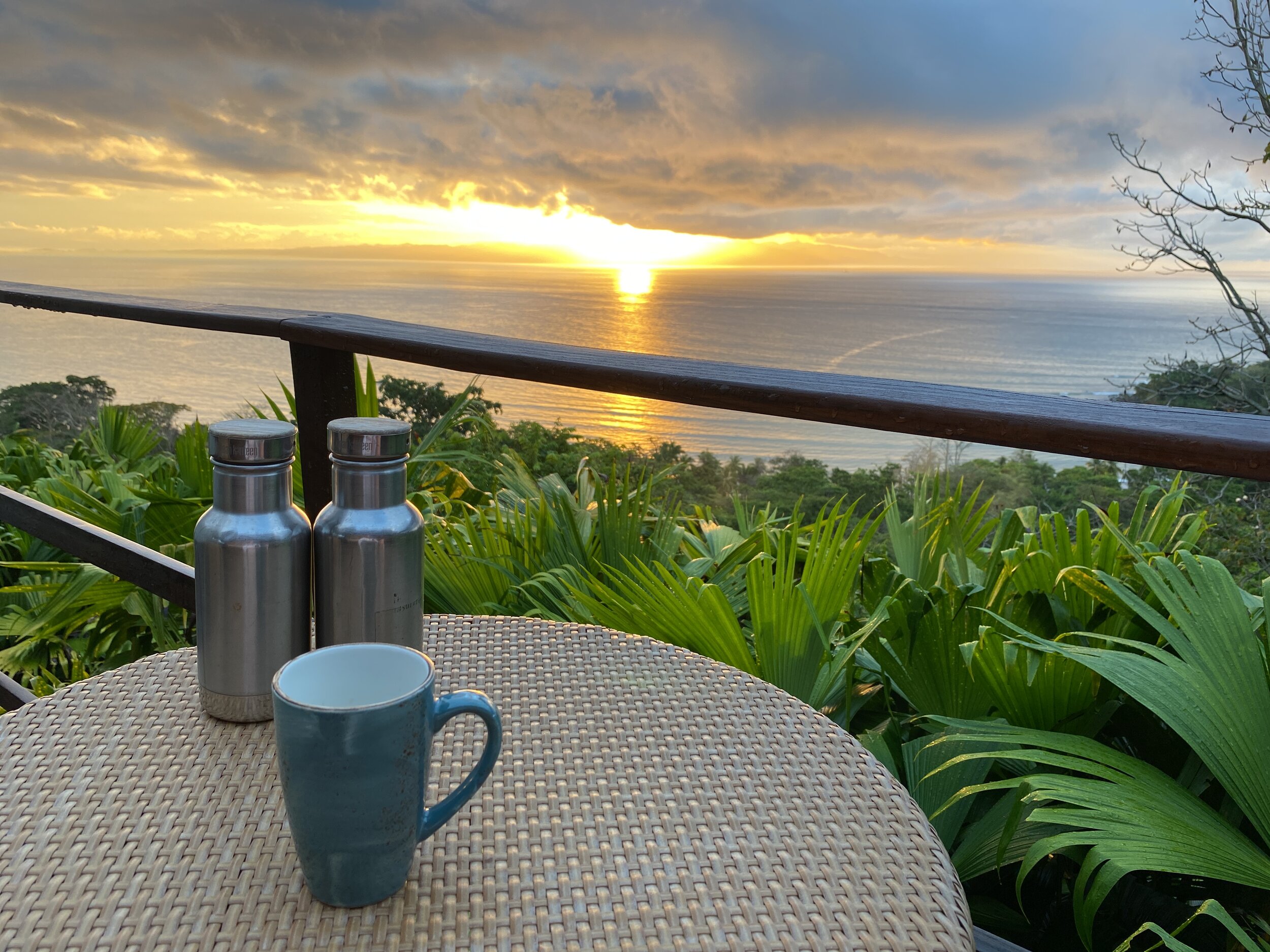
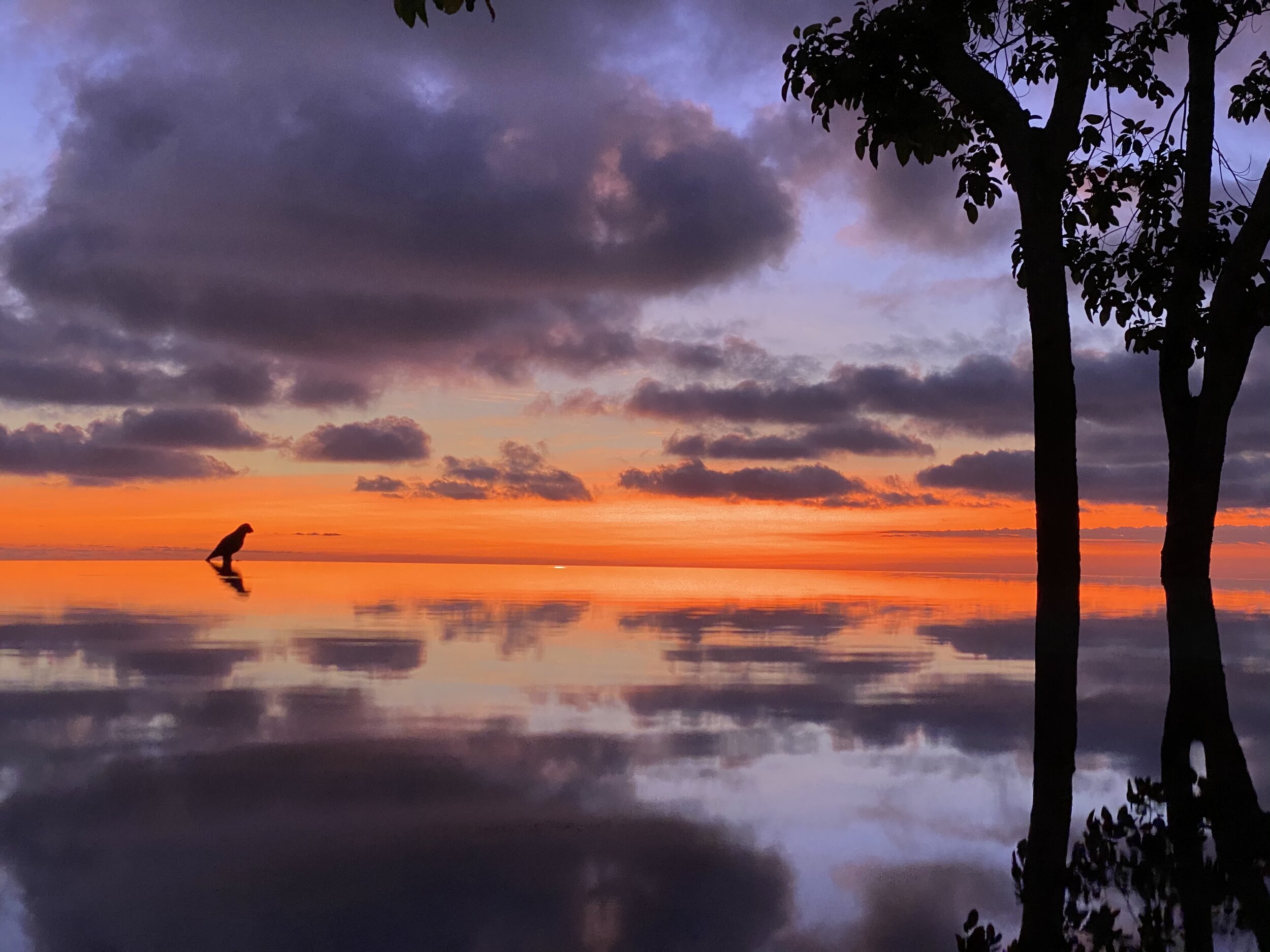
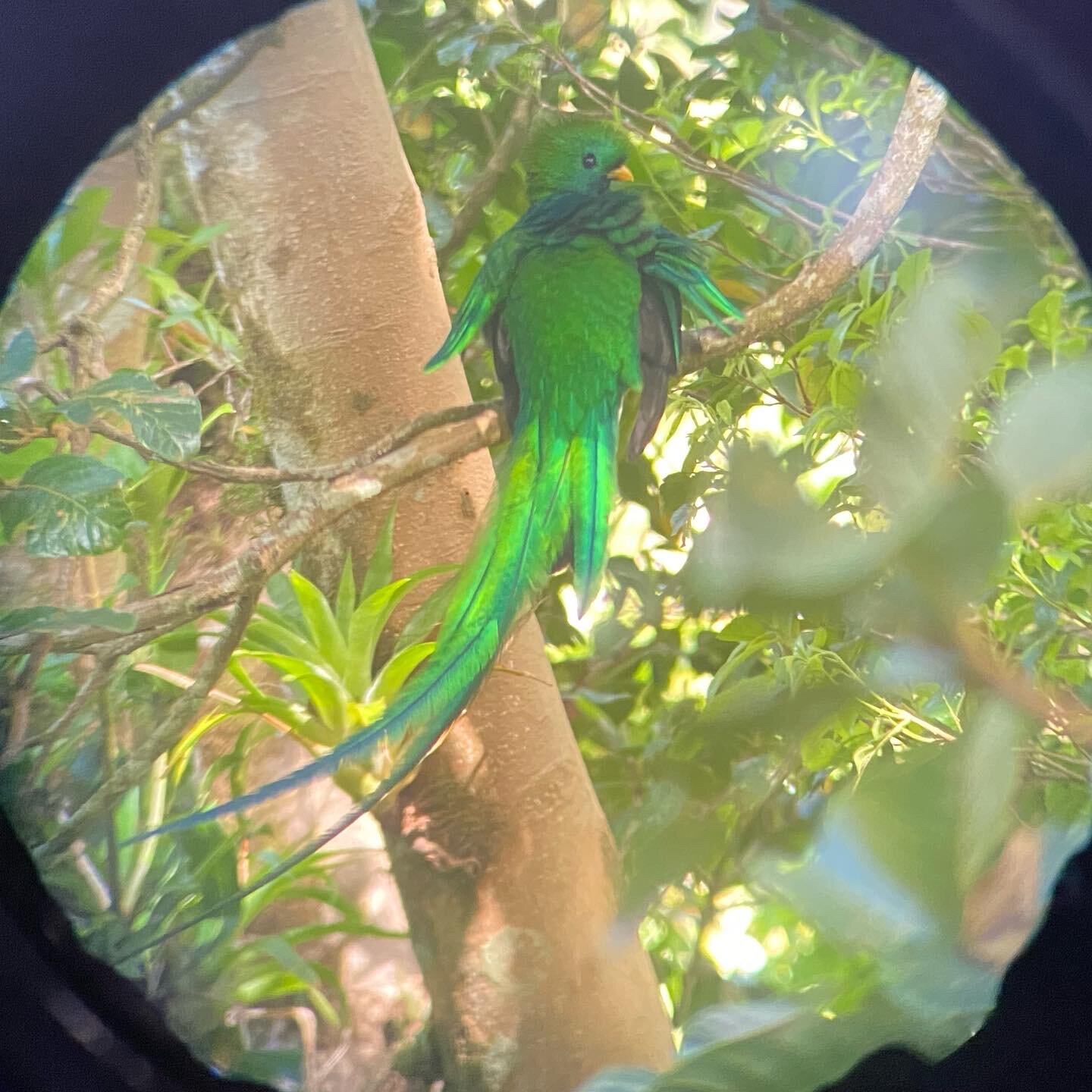
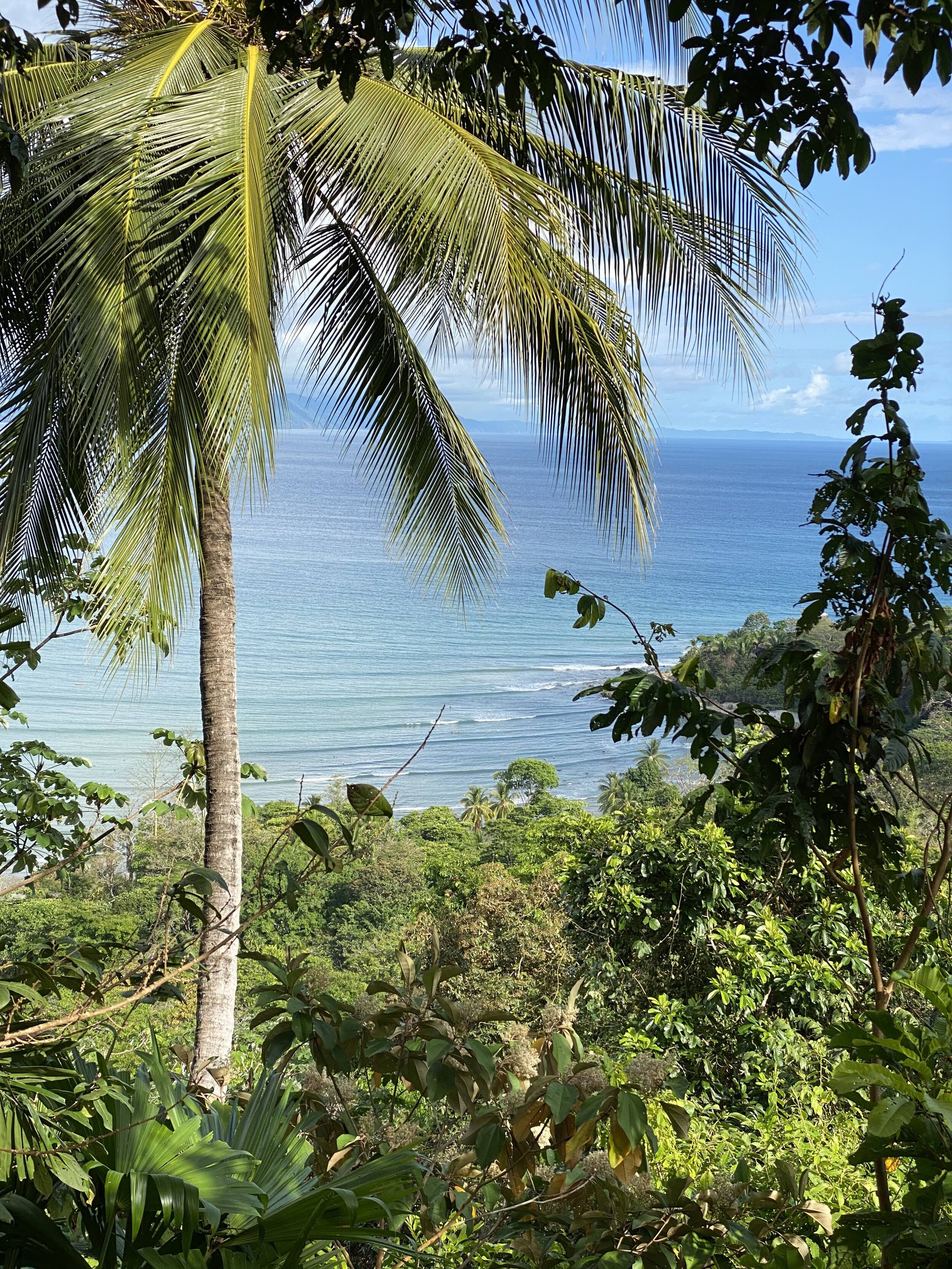
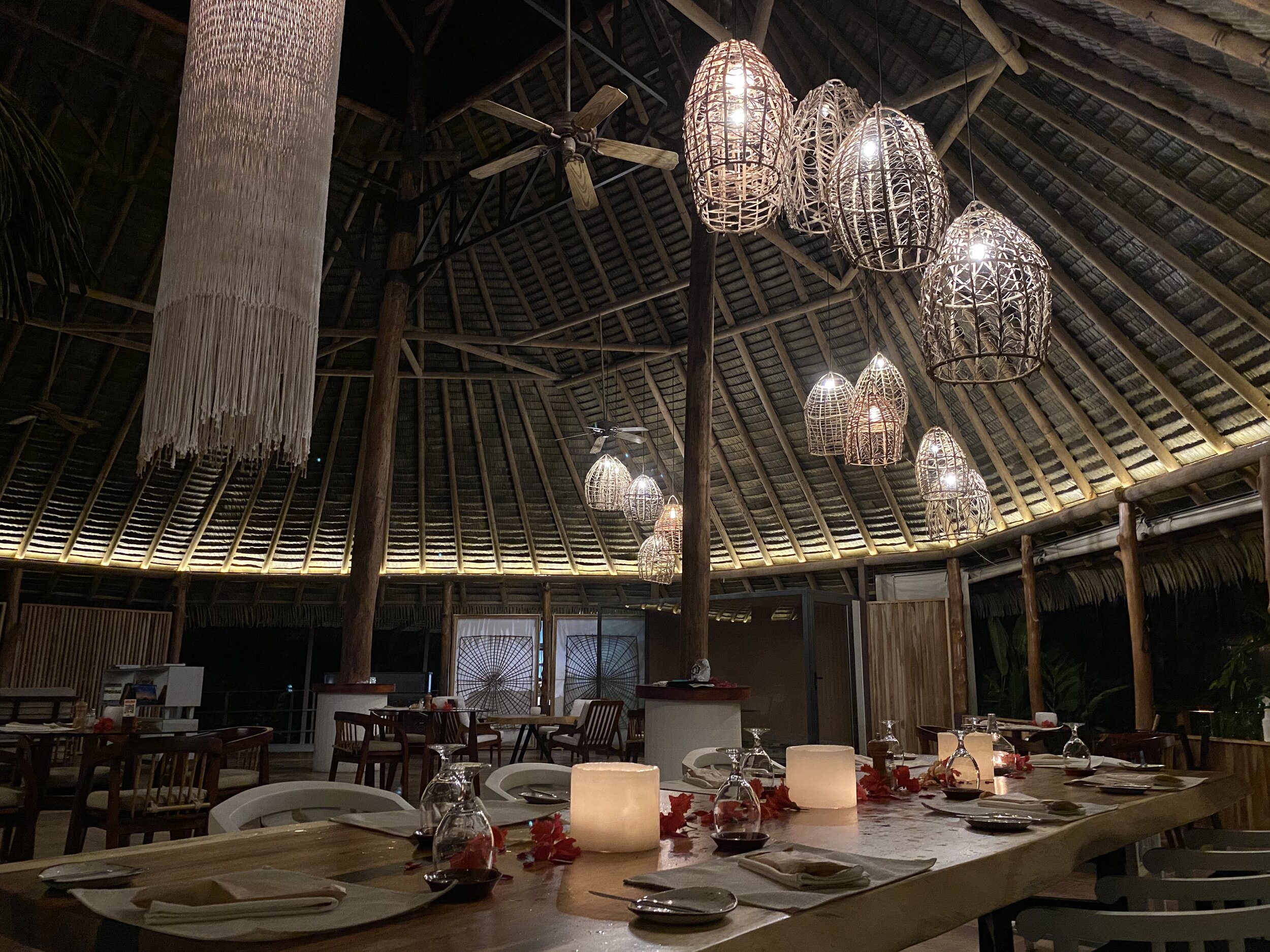
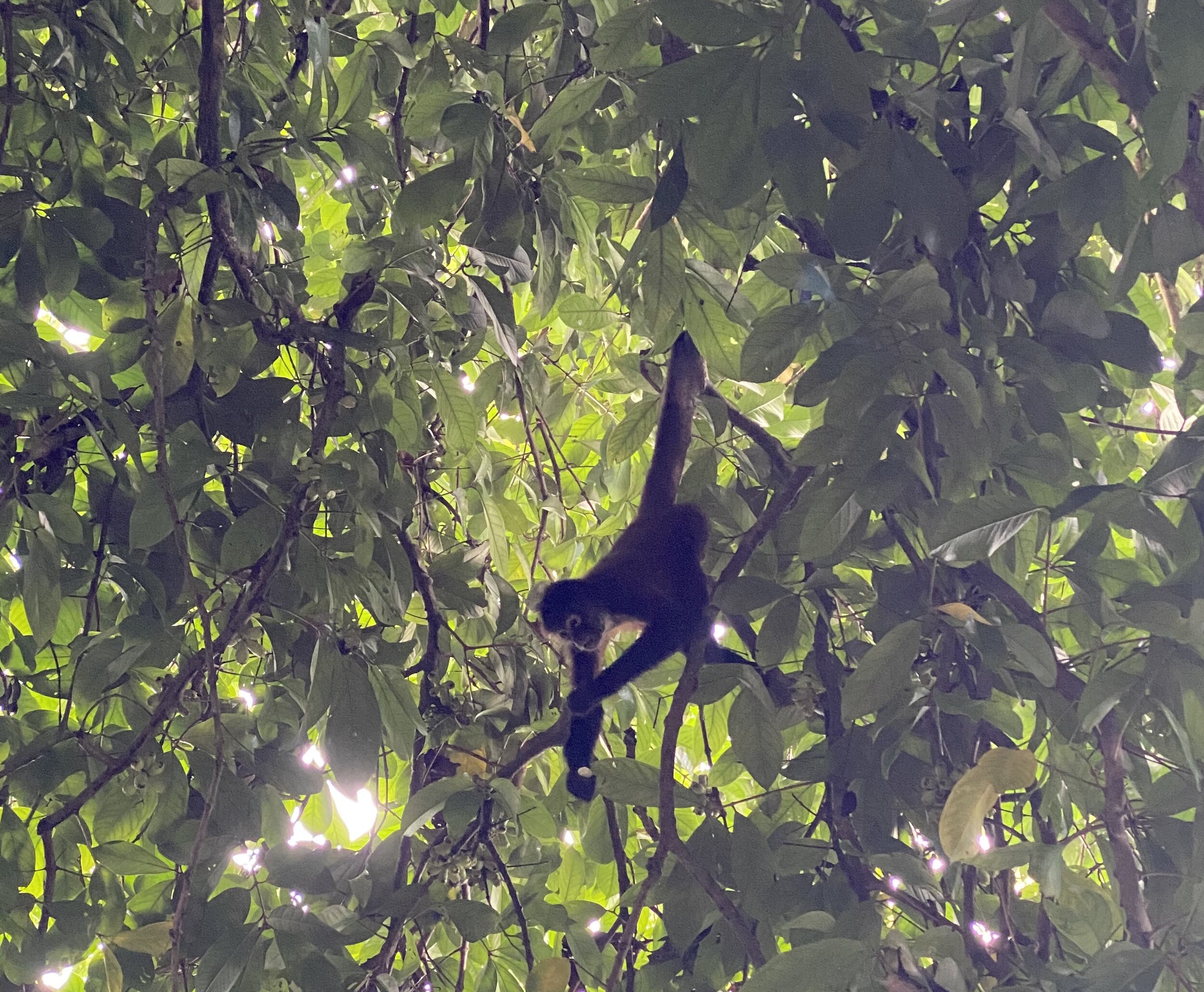
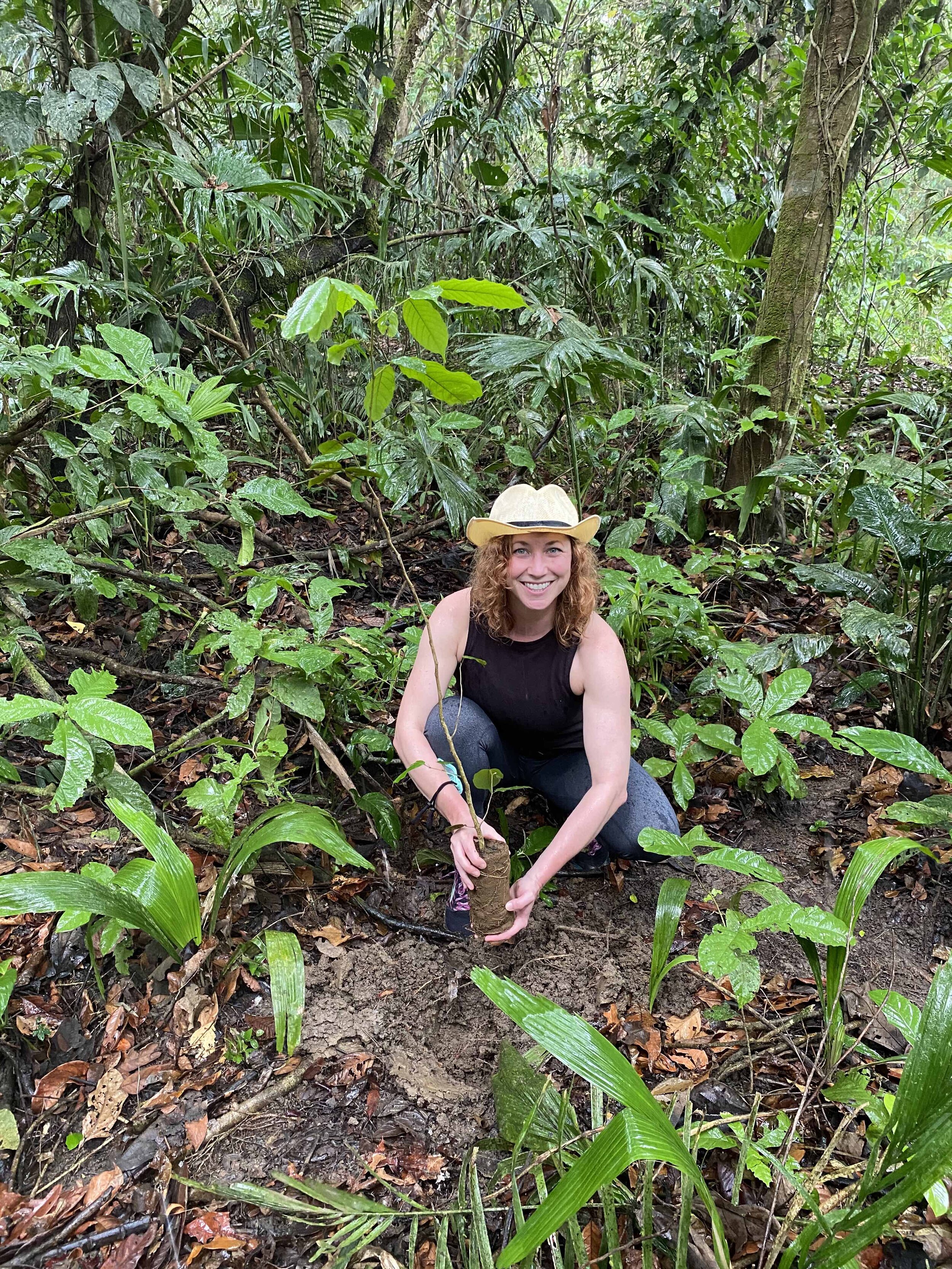
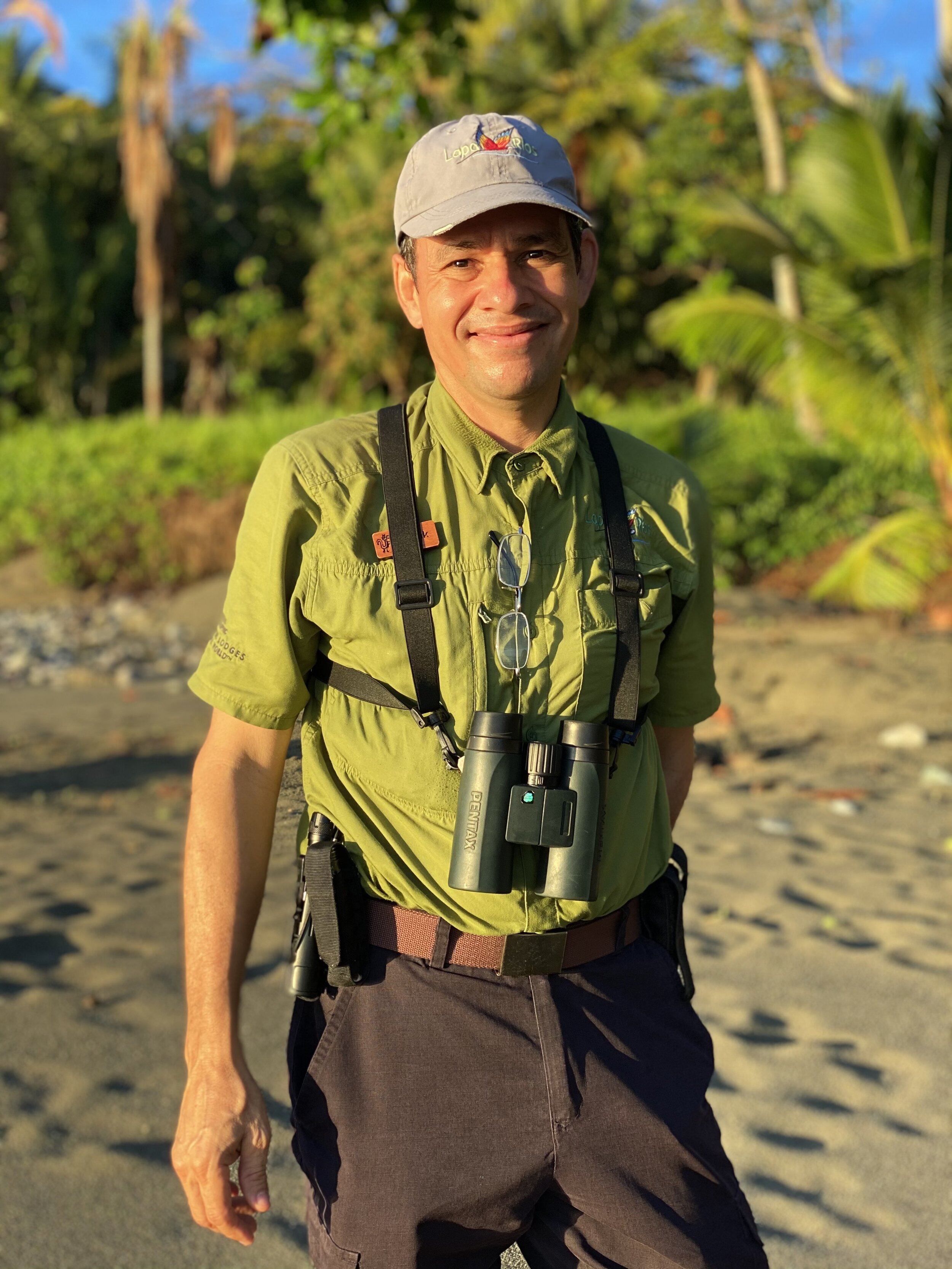
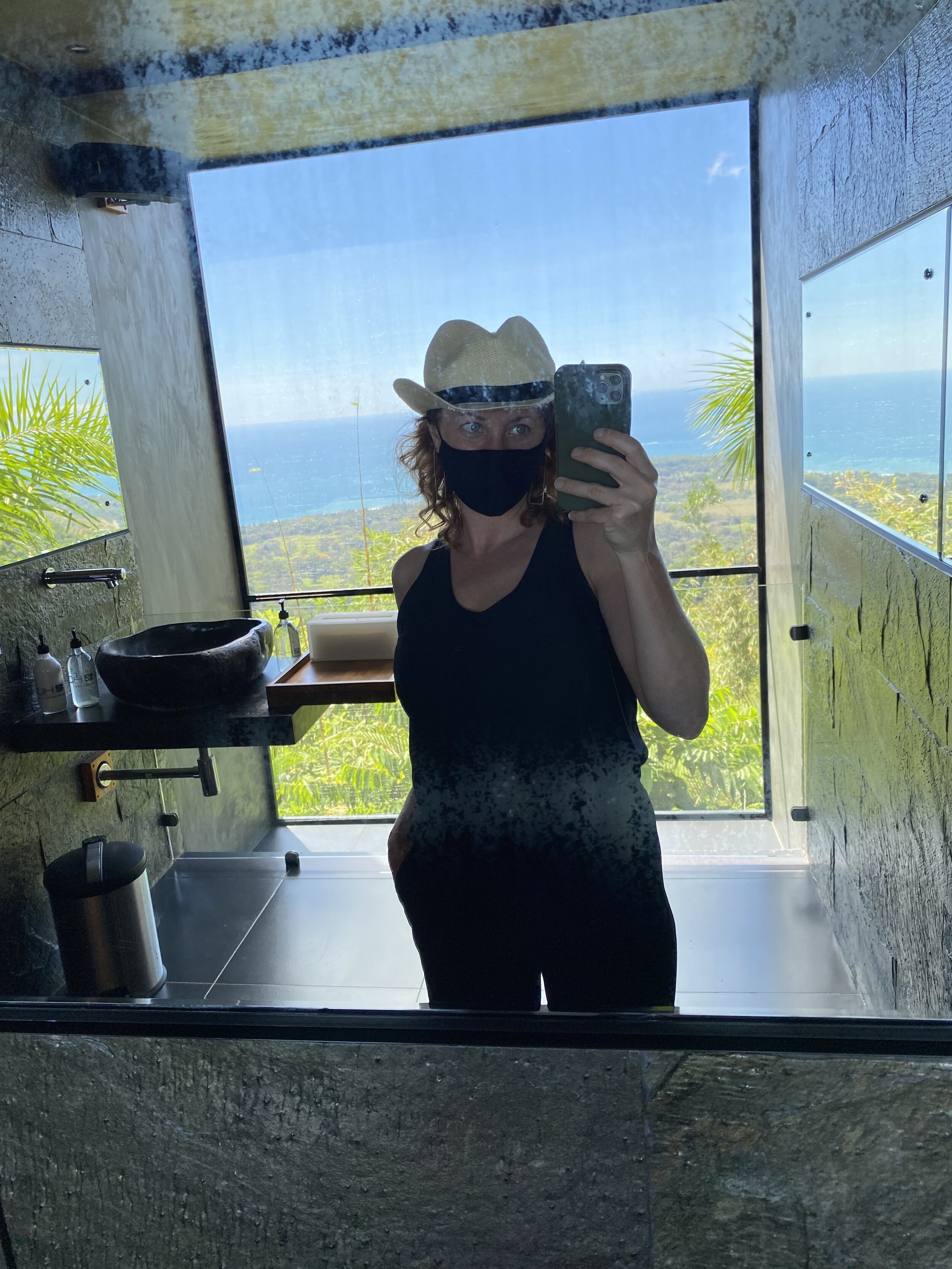
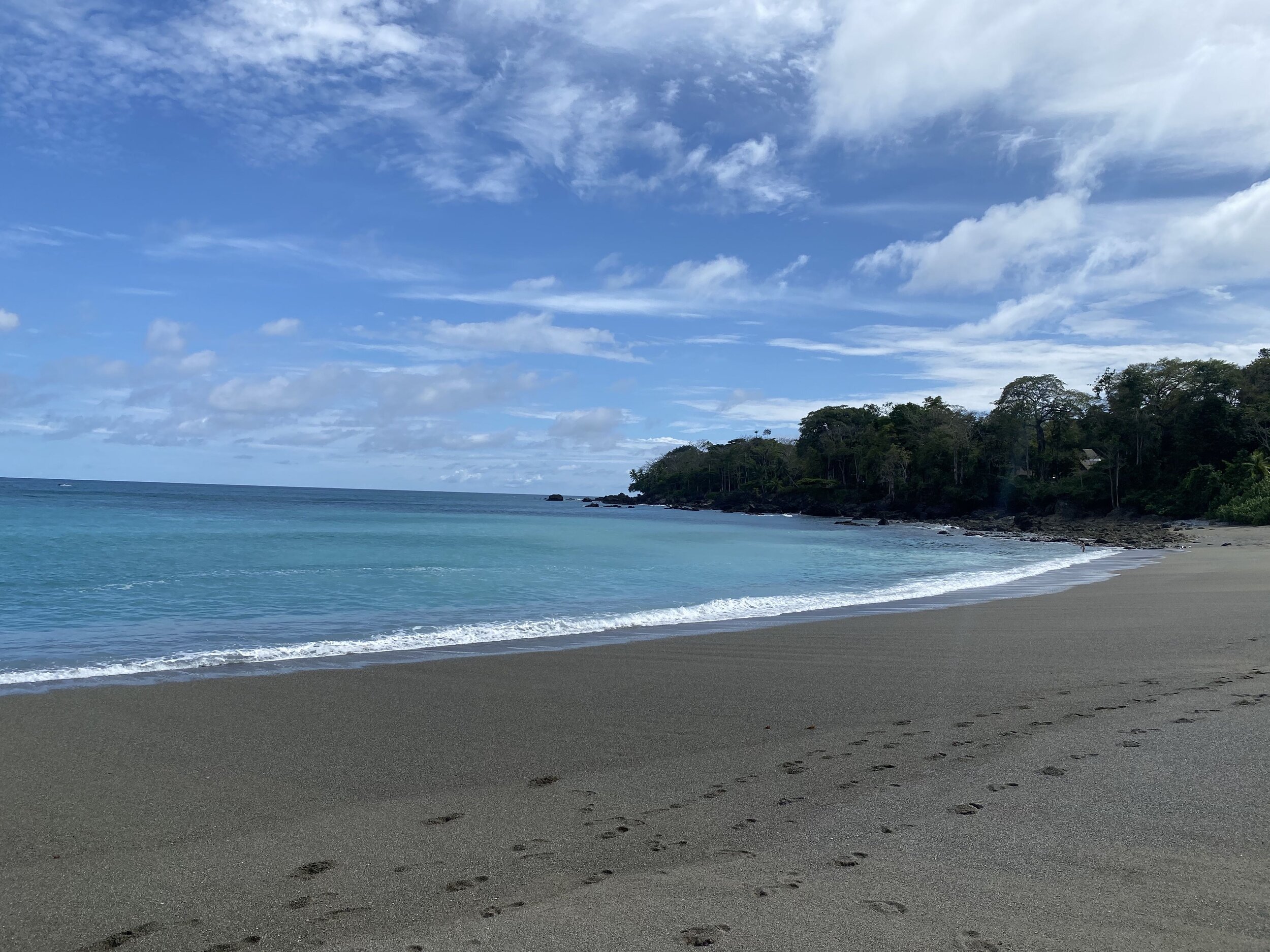
The Case for the South
Every country has its greatest hits, the same places that are on the list of each and every visitor. How often are these well known players the highlight of the trip vs. the surprise delight of somewhere unexpected?
In Costa Rica the Papagayo + Arenal Combo is everybody’s go-to, by and large utilizing the same handful of franchised beach resorts that could be located anywhere in the tropics. This is not to disparage what they offer (though I’m sure my tone implies otherwise), but to encourage you to nudge your clients south and dive into the essence of the country. To Uvita, to the Osa, to Monteverde instead of or in addition to Arenal, to the Caribbean Coast. Places that retain a unique sense of place and authentic Costa Rican-ness that hasn’t been over-branded and over-produced and expatted out of them. Then go to Papagayo. But just don’t only send your travelers there - it’s a purpose built “multi use luxury development complex” and is barely a taste of the variety of experiences that Costa Rica enables.
I could write a novel about each lodge that we work with but if I can make a case for just two places that I revisited on this trip, it has to be Kurà in Uvita and Lapa Rios Lodge on the Osa Peninsula.
“It is great to be down here, and it was so wonderful to experience Kura and Lapa Rios last week. Of course, everyone expects the beautiful views at the properties and all of the wildlife at Lapa Rios, but beyond that we felt that the staff at both properties were exceptional. They consistently went above and beyond and truly made us feel at home.At Lapa Rios we stayed in villa 15 – I thought the redesign was beautifully done! Sitting out on the terrace taking in the views with the wildlife all around was amazing. Definitely a highlight of the trip!”
Lapa Rios sits at the southern end of the Osa Peninsula, a destination renowned for incredible, record-setting biodiversity but less know for the amazing surf breaks that are easily accessed from the property and cater to all skill levels. When there, nature exists all around you - from the symphony of sounds as the rainforest residents greet each dawn to the monkeys scampering across your balcony to the toucans and scarlet macaws having breakfast overhead. The area around the lodge - protected forever as a conservation easement - vibrates with life in a way that is restorative and energizing. I felt so grateful to be back there, watching the sunrise from my deck each morning, while enjoying a cup of coffee and steamed milk, delivered to my door at 6:00 am.
Women leaders of Lapa Rios, from L to R, Paola Calderón (Head of Sustainability), Maureen Montenegro (General Manager), Cany Samudio (Administrative Coordinator) and Stephanie Rivas (Head of Guest Services)
But being immersed in the rainforest does not come at the expense of comfort. Lapa Rios underwent some major upgrades over the past year, and I was thrilled to finally experience these firsthand. Fiberoptic cable has enabled strong and fast WiFi in every room and all public spaces (which we put to the test when live streaming a Virtual Visit.) The new suites (Lapa Villas and Premier Villas) are enormous and gorgeous (View this VIDEO TOUR OF ROOMS HERE) and ideal for larger families. Evening Breeze beds provide a personal cooling system for those that desire it while sleeping. A lovely new bar and expansive deck maximize the views over the rainforest clad hills and turquoise blue Golfo Dulce. A largely female-led staff has been getting creative, setting up scenic and private dining options throughout the lodge, decks and around the pool. And the complete overhaul of the kitchen + culinary guidance of Greek Chef George Belesis has allowed for the creation of three separate a la carte multi-course menus which rotate daily and highlight local flavors in an elevated manner. With a variety of creative vegetarian options, I truly looked forward to every meal and only regret to not have sampled them all (some favorites are below) A walk-in, temperature-controlled wine room is being installed in the main lodge and an elevated ramp & hanging bridge is replacing the stairs that used to connect the main lodge & pool area to the first 10 rooms, making the trip between them both easier and more enjoyable. (Room 11 is being used for wellness treatments. Rooms 12-17 are the new villas and complimentary car service is included for guests in those rooms should they prefer not to walk.)
And the activities are endless. In addition to the 8 guided excursions included in the rates - covering everything from medicinal botany to early morning birding - one can paddle through the mangroves, kayak with bioluminescence, surf gorgeous point breaks, go dolphin and whale watching, rappel down waterfalls, discover the culture of the Osa with visits to local farms and families (some currently altered due to Covid) or take a day trip to Corcovado National Park on a boat that collects you right from the beach below Lapa Rios. I opted to do this on a Sunday and it was absolutely worth it to spot a mother and baby tapir at very close range. 100% powered by renewable resources and committed to conservation & regeneration, Lapa Rios is the premier choice for travelers venturing to the Osa Peninsula and time and again is the unexpected highlight from an entire trip to Costa Rica.
North of the Osa, above the beach town of Uvita, Kurà is as lovely as ever, perched on a hilltop with expansive views of the Pacific Ocean and Marino Ballena National Park with its uniquely shaped “Whale’s Tail sandbar. It is not a place to be seen with just 8 suites and catering to adult couples, but a place to hideaway, indulge in self care and reconnect with yourself and your partner amidst a beautiful location. Since my last visit there weren’t any major changes though a few small enhancements elevate the guest experience; an expanded premier wine list, personal wine fridges in each suite, a seamless, contactless communication system with the front desk to easily order every meal in your suite, portable bluetooth speakers in each suite that guests can take to the beach, tiny LED reading lights that clip to a book for when one partner wants to sleep and the other can’t put down a good read. Little details, but thoughtfully done.
Doing sunsets at Kurà - photo courtesy of Matthew LaPolice of Mayamaya Travel who stayed at Kurà & Lapa Rios in February.
Travel Advisors who have heard of Kurà but haven’t yet visited it themselves most frequently ask “what is there to do? it seems so isolated.” Honestly, you don’t come to Kurà to do. You come to be. To be cared for, to be surrounded by beauty, to just take a little sabbatical from life for a few days. You do sunsets at the pool because they really are an ethereal event in and of themselves. Maybe you do the beach one day, taking advantage of the private & complimentary Land Cruiser transfers to six different beaches that Kurà extends to guests any time they wish. Or pop down to Uvita to check out the weekly farmer’s market or dine at one of the up and coming restaurants (like the sushi & wine bar at the bottom of the hill.) But most guests come, take in the view, decide they aren’t leaving and opt to cancel whatever has been booked for them over the next few days to instead soak in the pleasure and peace of the place. And after a year of nonstop, stressful and challenging “doing” doesn’t that stillness sound nice?
Testing on Return Home
All air travelers to the USA must show proof of a negative Covid test taken within three days prior to their flight departure. To facilitate this requirement, Costa Rica has rapidly ramped up testing sites and labs throughout the country and in most cases hotels can arrange private in-room testing onsite for a fee.
PCR and rapid antigen tests are now available throughout the country. During my trip in mid-February, the rapid antigen tests were brand new, having just been approved (for travel purposes only) to begin on February 16. Generally these tests are less expensive than PCR tests, results are returned sooner and the experience is a little less painful as the swab does not need to go quite as deep into the nasal cavity.
Happy to mask up. Sad to head home. Planning my return.
Prior to returning home I had the team at Cayuga Travel schedule my appointment to be tested at Clinica Biblica in San Jose. (Yes, appointments are recommended) The cost was about $45, the testing occurred in the hospital’s parking garage and was administered in my vehicle and I had my results emailed to me in about four hours, in plenty of time for my flight the next day. Since that date, more labs have been approved to offer rapid antigen testing and the available sites across the country have only increased. THIS BLOG has the most complete and up-to-date list of testing that I’ve found in Costa Rica but even easier is just to ask your DMC what the options are. From my experience, I almost always need to spend the last night of my trip in San Jose due to west coast flight times, so getting a rapid antigen Covid test in the city was easy, affordable and efficient when scheduled in advance.
Have questions about travel to Costa Rica now? I’m happy to speak with your clients and give them an enthusiastic pep talk on why Costa Rica & pura vida really is a good idea right now. Drop me a note at kirsten@clarkkotula.com if I can help you with anything.
*As of late February, Costa Rica had welcomed more than 200,000 tourists. Just 250 of them had tested positive for Covid - an infection rate of just .13% which the Costa Rican Department of Health and Ministry of Tourism proudly share as proof that the decision to reopen the country and eliminate testing has not led to an increase in Covid cases from outside of its borders. This was the initial concern when the country eliminated the testing requirement for inbound travelers.
WiFi in All Rooms Means Remote Work from Lapa Rios
Stay connected while you escape to the pristine natural environment of the Osa Peninsula at Lapa Rios Lodge.
Work Remote from Lapa Rios Lodge:
High Speed WiFi Now in All Suites
Stay connected during your time at Lapa Rios Lodge with high speed WiFi available throughout the entire property, including all public spaces and in each Villa & room. Catch-up on your emails while you check the surf from your balcony, make everyone on zoom jealous with the ultimate tropical background and engage with the Osa Peninsula’s living classroom after virtual class time ends for the day. While Lapa still encourages all guests to disconnect from their devices to fully immerse in the Osa Peninsula’s natural wonders, they understand that staying connected while being remote is especially essential right now. Want to stay longer? Their Pay 3/Stay 4 Nights Promotion is valid for stays until October 31, 2021.
Fresh coffee, feet up and binoculars close by. How you do morning emails at Lapa Rios Lodge.
Another recent upgrade at Lapa Rios was the arrival of Evening Breeze beds. An energy efficient and more environmentally friendly alternative to air conditioning, Evening Breeze beds create a personal cooling micro climate around the sleeper, pulling air from under the bed, filtering and cooling it and then dispersing it through the overhead canopy. The system, a popular amenity in many top remote safari lodges throughout Africa, is completely silent and uses up to 80% less energy than a traditional AC unit.
Lapa Rios is also working with a lab in Puerto Jimenez to provide Covid testing for guests who need to secure negative results prior to returning home to the United States. Testing is currently available for $160 per person and is by appointment, M-Th. Please contact your DMC or Greivin Alvarez at greivin@laparios.com if you have any questions.
Stay connected, sleep soundly in comfort and let nature soothe your soul at Lapa Rios Lodge.
The People Behind the Experience: Elizabeth Steinvorth of Hotel Aguas Claras
An interview with Elizabeth Steinvorth, part of the mother-daughter artist and design duo behind Hotel Aguas Claras in Puerto Viejo.
The People Behind the Experience:
Elizabeth Steinvorth of Hotel Aguas Claras
In Hotel Aguas Claras, co-owner Elizabeth Steinvorth, a lifelong artist, has created a hospitality experience that not only tells the story of a place – Puerto Viejo – but also her own personal story, one that brought her from the capital of San Jose, around the world and back to the vibrant jungles, beaches and local community of Costa Rica’s Southern Caribbean Coast. Through an intentionally curated blend of personal creations, up-cycled furniture, Victorian architecture and the handmade works of numerous artist friends, Steinvorth and her daughter, Elena Rohrmoser, have brought to life a singular vision guests can feel with all of their senses, with a style and vibe that is 100% original. Perhaps that is why, during this most challenging of years for much of the tourism space, Hotel Aguas Claras is thriving.
Elizabeth & daughter Elena, on one of their first shared trips to Puerto Viejo.
Thanks to Elizabeth for taking the time to chat with us last month and share more of her story as one of our “People Behind the Experience”.
It’s quite a leap to dive into building and running a hotel from scratch after a lifetime as an artist. What drew you and Elena to this shared adventure in hospitality in Puerto Viejo?
Puerto Viejo has been my spiritual home since the first time I visited 33 years ago. I fell in love with the beaches, spectacular nature, wildlife, climate, and mainly the people and culture, which is more Afro Caribbean & indigenous (Bribri) than elsewhere in Costa Rica. I eventually purchased & renovated my own home here.
Mother & daughter
Elena and I are very close friends, apart from being mother/daughter. We love to travel the world together and have spent considerable time abroad. When I was younger, I studied to be a German and French translator in Germany for six years and Elena has been citizen of the world since she was 17 years old when she left to Berlin. She spent more than a decade in Europe and finally New York City where she studied Art and Design at Parsons.
Six years ago, after Elena returned to Costa Rica she and I initially had the idea to build a music studio together with our cousin Jorge who is a musician and artist in New York. So we started looking for the right location in Puerto Viejo and discovered that my neighbor was selling the old Aguas Claras Cottages right next to our house! After investigating the music studio idea, it turned out to be too complicated. But by then, we had also fallen in love with this property which I admired for decades. I decided to buy it and initially just restore the cottages to rent. And so it happened that we ended up with this huge project that kept us busy for the next four years!
With building a hotel we had little experience, but we knew we wanted to share this wonderful paradise with the rest of the world. And while Puerto Viejo is just starting to become an internationally known destination - it is and will continue to remain very natural and easy going, a characteristic that we’ve reflected in the hotel.
With shared but different backgrounds in art and design, can you tell us about the distinct styles of you and Elena and where you draw inspiration from? Where can guests see each of your personalities represented in the design and style of certain spaces?
I’ve been making things my whole life – expressing myself through music, dance, art. From a very young age I practiced ballet, played the piano, painted watercolors and created all kinds of handicrafts, and I love to create something every day since then. Currently (or before the pandemic), I really enjoy attending art workshops and traveling around the world – to Bali, Japan, New Zealand, South America to mention a few, which has opened my senses, taught me new techniques and expanded my creativity even more. I have also always been extremely conscious of keeping this world clean, and many years ago decided to include elements of up-cycling in all of my art projects, believing that and anything that can be made beautiful and useful again.
Guests can see my personality represented in the mirrors throughout the lobby of the hotel and bungalow rooms. I made these from egg cartons, old magazines, lids from glass jars, and may other materials which are usually thrown away, I think about 70% of furniture we have - including the shutters, balcony railings and floor boards - have been up-cycled and refinished by me, and much of it was saved from the old Aguas Claras Cottages. Also my flower watercolors can be seen in Casa Floralia, and several lamps and other ceramic objects here and there are my creation. I love color so all of my art work stands out against the white walls of the hotel, just enough to not compete with the bright colors of nature surrounding us.
Elena’s personality is very evident in the design and decor of our Papaya Restaurant and Pavlova Sweets, each one with a different theme or influenced by a different artistic acquaintance. She also curated many of the items we’ve showcased in our Libelula Gift Shop, clothing, jewelry and art objects that are all hand made. Our Beach Club “Da Lime” is a mixture of Elena’s and my taste, the perfect combination!
If you had to pick three “signature pieces” that represent Hotel Aguas Claras, what would they be?
Close up of the chandelier that hangs above the bar in Papaya Restaurant
First, the Chandelier hanging over the bar at Papaya Restaurant was created by my friend Natasha Nokin, a French artist living in Puerto Viejo 30 years ago, and me. It’s a combination of 5 lamps, each created from old lamps that belonged to my family, plus chandelier crystals, shell beads and bamboo pieces as well as other local materials. Since up-cycling is always my goal, exhibiting this chandelier is the perfect example of how old pieces and any kind of natural materials and objects can be put together with an excellent visual effect.
Second - the Iron columns at the lobby entrance and fountain. These unique pieces belonged to my good artist friend Antonio Doninelli, who has been a frequent collaborator on the hotel and surrounding gardens. They came from England and date from the 19th Century, when Costa Rica started exporting coffee for the first time. At that time, Costa Rica’s president used the ships exporting coffee to bring back many ornaments from Europe, especially for the creation of our National Theatre, which emulated popular architectural styles in Europe. These columns stood for many years in the gardens and residences of the old Presidential Home until we acquired them, incorporating a piece of Costa Rica’s global history into our gardens.
Fountain made with coral blocks discovered during the construction of Hotel Aguas Claras
Third - the coral ornamentation throughout the gardens of Aguas Claras:. The property of Aguas Claras used to be covered by water; today we sit atop a platform of coral some 3 meters under the ground. When we started to excavate for the hotel’s foundations, we found thousands of pieces of coral! We wanted to use it somehow and pay homage to the property’s natural history and found in town a Spanish stonecutter. Using our designs he created a series of benches, pedestals and floors found throughout the gardens of the hotel. They are a work of art for sure and I was inspired by the use of coral in Viscaya Castle in Miami and architecture in La Habana, Cuba.
Tell me more about Familia Paraíso – who have you hosted and who would you like to host in the future as an artist-in-residence?
Familia Paraíso is the creative multimedia platform for Hotel Aguas Claras. It serves as an archival library for all the art forms created at the Hotel by artists in many creative disciplines that come to visit us locally and from faraway lands. It is also a space to build and promote the creative community we have here in Puerto Viejo, showcase all the beautiful things happening at the Hotel and inform of future Artist-in-Residencies, Events and Environmental Community Projects.
We have hosted and collaborated with musicians like Andrew Van Wyngarden from MGMT, California band Allah-Las, Soko (French actress/musician/model), NYC Designers Dusen Dusen and Susan Alexandra, Costa Rican Artist Federico Herrero who has come to host a creative workshop with the community kids, Director and Photographer Stuart Winecoff, among many others! The idea is to continue inviting inspiring individuals from creative and environmental fields and we welcome proposals from different artists around the world which match our vision and values.
Our intention is to serve as a cultural bridge between our local diversity and the guests that visit us through the key element of collaboration and exchange.
Traveling with more intention and consideration of our impact and footprint is a theme for post-Covid travel. What do you want visitors coming to Puerto Viejo to know about the place and be mindful of?
We would like visitors to know about our environmental efforts to protect nature, the Caribbean heritage and to be inspired by these - because that is what makes Puerto Viejo unique among Costa Rica’s beach towns. Every guest should participate in our sustainability tour - these show every practice taken at the Hotel as well as the history of this place, which is very important to understand the culture and landscape of Puerto Viejo.
What other hotels or destinations have influenced you (beyond Costa Rica) and Elena?
We’ve both travelled a lot together ever since Elena was quite young and believe that a key element of a great experience are the memories and the feelings that a particular place can leave you with forever, that you can access later on in life. Two very joyful trips I remember are both road trips that we took together, one in California where we drove Highway 1 from Los Angeles to San Francisco and stayed in several hotels along the way. They were all so different but special! Ventana Inn, Chateau Marmont, Ace Hotel in Palm Springs and a really kitsch but very unique one with themed rooms called Madonna Inn in San Luis Obispo. The other was in Italy where we went to Porto Ercole. We stayed at a friend’s family style B&B and then at Il Pellicano, a beautiful hotel which has a special history and really was an inspiration for Hotel Aguas Claras. In terms of attention to detail and a very personal and beautiful service I will never forget a trip we did to Indonesia on a yoga retreat. For me, the unique and sacred approach to hospitality in Asia and the feeling it leaves you with is unmatched in the world!
Where are you going when international travel reopens for Costa Ricans and you feel comfortable moving around internationally?
I would love to visit Oaxaca again, attend art and cooking workshops. Know more and learn about their textiles, natural dyes and how they are made. And The Galapagos Islands are also a place I would love to visit.
Ecuador & Galapagos: Where and How to Travel Now
Whats the current state of travel in Ecuador in October 2020? We share some tips and advice for arranging trips there now.
Ecuador & Galapagos: Where and How to Travel Now
Ecuador was one of the first and hardest hit countries in South America by Coronavirus at the beginning of the pandemic. The terrible months of March and April resulted in some of the most severe lockdown measures of any country on earth, the results of which have continued to trend positive until today, the curve flattened in May and has stayed that way. The US Department of State dropped the travel warning for Ecuador to Level 3: “Reconsider Travel” - one of only 5 countries in South America.
Reality Check: Just to put statistics in perspective, since the majority of readers of this blog will be US based travel industry professionals referencing destinations to pitch to their clients: The entire country of Ecuador with a population of 18 million has recorded 141k total cases of Coronavirus since March 17th - while Los Angeles County, with 11 million inhabitants, has recorded 275k case in the same period. (Ecuador shows a 0.007% infection rate vs LA County at .025%)
Since May, Ecuador has cautiously opened their economy, bit by bit, and by July 1st the hotels which we represent on mainland Ecuador (Casa Gangotena, Mashpi Lodge, Hacienda Zuleta) reopened, but in a limited capacity and only to local Ecuadorian guests as the international borders remained closed. This move however, of allowing the hotels to welcome Ecuadorian guests proved to be great, allowing the hoteliers a limited stream of income, but more importantly, the ability to retain key staff and refine their operations and sanitary protocols over time, in preparation for welcoming international visitors back. They have not gone from zero to sixty overnight, they have been looking after guests safely for three months now, they are running solid operations and their staff are accustomed to the new reality of travel.
On July 1st, Ecuador reopened its borders to international visitors and the frequency of commercial flight routes and frequencies has continued to grow. Currently, as of October 7th, the following list of major airline carriers have multiple direct flights weekly to both Quito (UIO) and Guayaquil (GYE), the principal international gateways.
United from Houston to Quito
American Airlines from Miami to Quito and Guayaquil
JetBlue from New York to Quito and Guayaquil
JetBlue from Fort Lauderdale to Quito
Copa Airlines from Panama City to Quito
AeroMexico from Mexico City to Quito
KLM from Amsterdam to Quito and Guayaquil
AirEuropa from Madrid to Quito
Iberia from Madrid to Quito
So what are the entry requirements? Visitors from any nation are allowed into mainland Ecuador by showing a negative PCR Covid test taken within 10 days of flight arrival (not needed for children under 18). A basic heath questionnaire needs to be filled out and temperature checks are given upon arrival. Once you have satisfied these requirements, you are free to circulate around the 23 provinces of mainland Ecuador. With the variance in how quickly test results are being returned (in the United States) this 10 day window makes it very easy to prepare for departure, and the flights to/from Ecuador have been operating normally.
You notice that I keep referring to “mainland Ecuador”? That is because the #1 tourist attraction in Ecuador is the Galapagos Islands, which are just one of the 24 Provinces of Ecuador, but sit 800 miles off the Pacific Coast - and they have their own separate entry requirements. In order to visit the Galapagos Island, visitors must show a negative PCR test taken within 4 days (96 hours) of arrival in the islands (not needed for children under 12), show proof of travel insurance which includes medical coverage, and a safe-conduct permit from your cruise or tour company.
So all in all, Ecuador and the Galapagos is open. But with mainland Ecuador and the Galapagos being two very different travel experiences, with different requirements, how best to go about organizing a trip there? Below, I’ll break it down for you and provide some ideas, suggestions and things to consider in planning trips there at the moment.
Time to contemplate. Deep in the Mashpi Reserve in the Cloud forest of Ecuador
1) Mainland Ecuador is good to go. The requirements for entry are easy, flights are abundant and stable, and there is so much to see and offer on mainland Ecuador that it is deserving of its own trip, without the Galapagos. Most visitors to Ecuador don’t even spend much time on mainland Ecuador in their rush to the Galapagos and back; but the country has Amazon Rainforest, High Andes, Cloud Forests, Tropical Coast paired with an incredible Cultural and Historical diversity, all easily reached in this small compact country. The visitor experiences that mainland Ecuador offer are naturally socially distanced - this isn’t a destination for museums or group touring, it is about nature, wildlife and open space - enjoyed on private customized itineraries. To give you an example, below is a fantastic 10 day, door to door itinerary, that may interest your clients which includes Casa Gangotena in Quito, Mashpi Lodge in the Cloud Forest and Hacienda Zuleta in the Andes.
*Feel free to save and share this itinerary with your clients, you can replace the logo and contact details with your own in the header and footer. You can have this itinerary quoted by your DMC or Tour Operator of choice, or work with the properties direct. f you need help with this document or how to book, please email me.
2) If you have a couple or family looking to go somewhere to work or school remote for an extended period, there couldn’t be a more ideal place for this than Hacienda Zuleta. The historic Hacienda building dates back to 1619 covers a whopping 150,000 square feet of space, with the most delightful areas to work from tucked throughout the charming hacienda - and rock solid wifi. When work or school is done, you have a 4,000 acre private farm and wildlife conservation area to explore by foot, bike or horseback - and you don’t have to worry about cooking or cleaning! Weekends can be spent exploring other parts of Ecuador. Zuleta has been a home away from home for my family and children for many years, it’s the place they always want to go back to, always feeling at home and well looked after by Fernando and the local Zuleta community. Zuleta is offering up to 35% discounts on stays of a week or more with additional discounts for children. If you have clients interested in this, please email Gabriela at Zuleta, who handles international reservations.
Two women from the community, enjoying some sunshine in the courtyard of Hacienda Zuleta, doing embroidery and catching up on news.
3) Now on to the Galapagos….which is primarily known as a cruising destination. It’s should be easy enough to get clients from your home to the Galapagos within the 96 hour testing window. But make sure you can count on the PCR test turnaround times, calculate the flight connection times from their home to Guayaquil or Quito, calculate an overnight in Quito or Guayaquil prior to the Galapagos flight the next day, and of course factor in some buffer time should there be a flight delay or missed connection. The alternative to this is to have clients enter mainland Ecuador on the 10 day test, arrange another test for them upon arrival and then go stay somewhere for a few nights while they await test results and then fly to the Galapagos. The reality is that there are fewer people coming to the Galapagos right now than to mainland Ecuador due to these more stringent measures and the added logistical complexities of getting to the Galapagos. Add to this the inherent public concern about being on a cruise ship for multiple days in close contact with other passengers and crew, and a greatly reduced number of available flights between Mainland Ecuador and the Galapagos - plus the reality that some (not all) cruise ships, due to lack of demand, are forming pools with other vessels where travelers may end up on a different vessel and itinerary than what they booked, if the occupancy for the ship and itinerary your clients booked is very low. All of these factors understandably combine to make travelers uneasy about booking a Galapagos trip at the moment, the Galapagos is one of those once in a lifetime bucket list trips, and consumers are anxious to shell out for such an expensive trip under such uncertainty. But for the intrepid who want to go now, I couldn’t imagine a better time to be in the Galapagos with so few visitors, and how incredible the wildlife viewing must be since they have been left alone by tourists for six solid months. The experience would be akin to those advisors traveling to Africa at the moment witnessing the great migration all to themselves. My real concern is that since operating in the Galapagos is such an expensive business, and the industry has been decimated since March, there are some tour operators that are willing to do whatever it takes to make bookings right now - they desperately need the income (well, we all do). So combine the inherent group travel nature of the Galapagos, a lack of healthcare capacity in these remote islands, and a small number of reckless players in the industry - the situation is ripe for an outbreak, which if happens now, is only going to damage the Galapagos tourism industry even more (and Ecuador as a whole) through viral press coverage. So be sure to work with established, well run and responsible operators - I sincerely want to encourage people to travel to Ecuador and the Galapagos now, but sensibly.
The Galapagos Safari Camp, remote and private in the highlands of Santa Cruz Island
3) What about the Galapagos Safari Camp which you represent? The Galapagos Safari Camp has always served as an amazing alternative option in the Galapagos for those looking for more a more private and customized Galapagos experience, ideal for those travelers that are not keen on joining a group tour on a cruise ship. The small size of the property, located in a remote portion of the highlands with the luxury tented accommodation and private villa were virtually made with social distancing in mind, before it became part of our global lexicon in 2020. The owners, Michael and Stephanie, are in no rush to open due to the concerns I’ve outlined above - but are offering completely private takeovers of the 3 bedroom family villa on property or the 9 luxury tents. Those groups would have their own private guide and private chartered day yacht vessels to explore the outer islands just with their own group, no mixing with other visitors. During normal times at Galapagos Safari Camp, as an example pre-COVID, we may have 6 different bookings at a time, each doing their own customized itinerary but potentially mixing together for the day yacht excursions to outer islands - as well as having guests that are staying with us post cruise. They are not willing to offer these sort of semi-shared excursions at the moment nor are they accepting guests that are disembarking from cruise ships. So if you have a group or family from 4 up to 16 people in total, we have completely private programs to offer them beginning in November - and on top of that, we have key holiday season dates available. Please email the owner, Stephanie Bonham-Carter directly to receive the details of these programs.
Sundowners at Galapagos Safari Camp, in Private
Please remember that I am here to assist and guide you should you have any inquiries for Ecuador & the Galapagos, just email me. And this website has great tools full of marketing materials, PDFs, Videos, Images and Sample Itineraries.
I will personally be traveling to Ecuador in the next few weeks, and will be producing a daily video blog of the experience to share with you and your clients, of the current reality of traveling there. I’ll send more details on that when my dates are set.
Sending you positive energy-
Clark
Costa Rica: Where & How to Travel Now
Costa Rica is poised to welcome citizens and residents from all of the United States on November 1st after over two months of selectively staggering international tourism and focusing on the domestic market. Find all the latest info on entry requirements, in -country regulations and steps being taken by our partners to welcome your travelers back safely and warmly.
Costa Rica: Where & How to Travel Now
Since closing it’s international borders in March, Costa Rica has effectively controlled the Covid-19 outbreak throughout the country. As of October 3, 2020, Costa Rica - with a population of over 5 million - has 79,182 cases of COVID-19 (10,650 of these are “Por Nexo” which is a way of counting everyone in a household that has a confirmed Covid case as having the virus, though this is done without a test) and 950 fatalities.
Domestic tourism with regulations has been permitted in the country since June and Costa Rica has taken smart strategic measures to encourage residents to explore their own country. (For example, all national holidays in 2020 and 2021 were moved to Mondays so that Costa Ricans can enjoy long weekends to travel around the country and extend their stays.) And our hotel partners have all been open and welcoming the high-end local market, which has allowed them to dial in the new protocols, streamline operations within current restrictions, and most importantly, the hotels have had a vital revenue stream over the past several months, enabling most of them to increase their payroll & hiring by 50% since June.
Says Hans Pfister, Co-Founder & President of the Cayuga Collection “It’s very, very hard to go from 0 to 100 or even 0 to 75 overnight. Hotels that have stayed closed must hire and retrain staff, ensure everyone understands and follows the new protocols and figure out their own supply chains and what is possible. You can have a plan, but you can’t really determine how well it works until you can apply it in real time. For the Cayuga Collection Hotels, being open and catering to the high end local market for months now has given us plenty of time to “practice” in a way, ensuring we are 100% ready for the return of international guests. Our hotel teams are also excited and motivated, seeing their hard work and dedication over these difficult months pay off.”
Part of this dedication is because the hotels which Clark and I partner with throughout Latin America are owned by individuals as opposed to boards of investors, and in this case, 4 out of the 5 hotels that we represent in Costa Rica are owned by local Tico families - they are passion projects born out of love of place as much as they are businesses. People travel for different reasons but this is something for advisors to consider when discussing Costa Rica travel plans with your clients - suggesting hotels that have been open, supporting the local economy and doing things right for months vs. those that have been closed and don’t plan to reopen until mid November or festive.
Morning set up at Hotel Aguas Claras
Now for all of the details.
Who Can Visit Costa Rica: As of November 1st, all United States Citizens can enter Costa Rica for tourism purposes.
Costa Rica is also currently open to all citizens and residents of Canada, Mexico, the UK, the EU Schengen Zone, Australia, New Zealand, Uruguay, Jamaica, Japan, South Korea, Thailand, Singapore, and the People’s Republic of China.
Requirements for Entry: All travelers arriving in Costa Rica must present the following:
Prior to departing the US, complete the online Health Pass Form. Each passenger must answer this health pass individually and after the completion of the health pass, they will receive a QR and alphanumeric code that they must carry on their mobile or printed on paper to present to authorities at the airport.
Travel Insurance that guarantees coverage of at least $50,000 USD in medical expenses in the event of becoming ill with COVID-19 while in Costa Rica AND a minimum of USD $2,000 for lodging expenses required as a result of contracting the virus (trip interruption insurance to cover quarantine expenses) Travelers should ask their insurance company to issue a certificate stating these coverages. Policies vary and everyone needs to do their own due diligence.
Travelers may also opt to purchase insurance through Sagicor, a Costa Rican company that offers policies in accordance with the government mandates. This can easily be done online here: Tienda Sagicor Sagicor also has a desk in the San Jose International Airport where they will examine traveler’s insurance policies on arrival and if 1.) the policy doesn’t meet the requirements they can sell them coverage that does or 2.) issue the necessary certificate that verifies the the coverage offered by an international policy meets the governments requirements.
Gurpo INS, the International Insurance Company in Costa Rica also offers coverage but the interface on their website is terrible and hard to navigate. We can’t recommend that anyone attempt it!
While the insurance bit may pose a slight inconvenience, it’s important to assure your clients that they will not be barred from entry into the country if they somehow purchased the wrong insurance at home as long as they obtain the additional necessary coverage on arrival.
Costa Rica no longer requires any Covid testing as a condition for entry.
More information can also be found on Visit Costa Rica
International Flights: Right now there are a handful of direct nonstop flights to San Jose International Airport from the following USA airports. Schedules are much better if you are on the East Coast as all of the West Coast must currently fly through Houston.
Newark: United Departs EWR daily at 7:15 am and arrives in San Jose at 10:30 am. Gotta love a flight that aligns well with hotel check-in times! You can be on your way to the beach and enjoy a late lunch surf side by 2:00 pm.
Miami: Two nonstops per day on American Airlines, a morning and evening option, both have you in San Jose in about 2 hours, 30 minutes. (Also, when I checked for this blog post, roundtrip tickets in Standard Economy were $230 each for flights during the second half of October.)
Houston: One flight daily on United, departing IAH at 9:37 am and arriving SJO at 12:25 pm.
Delta, Alaska, Southwest and JetBlue have yet to resume their service to Costa Rica, and we don’t talk about Sp*r*t. But there are rumors that the first four airlines will begin direct service from Atlanta, Dallas, Boston and Fort Lauderdale at the end of October or early November. United also plans to restart direct flights to San Jose from Denver next month.
Domestic Flights: SANSA, the national domestic carrier in Costa Rica hasn’t resumed full service yet due to a lack of demand. The fleet of 12 Cessna Grand Caravans is fully operational so we expect more domestic flights to become available as passenger load increases over high season. But for the time being, they are not entirely reliable and scheduled departures are frequently cancelled or rolled into a single option.
So How Do You Get Around Costa Rica?: In the absence of regularly scheduled, reliable commercial flights to more out of the way destinations (think Osa & Nicoya Peninsula, the Caribbean Coast) private charter flights are a great option, especially for family or friend groups of 4 or more. We’ve always championed private aviation in Costa Rica - it make zipping from the Pacific to the Caribbean side of the country a breeze (compared to an all-day driving adventure on windy mountain roads) and the terrain you fly above is BEAUTIFUL - Napali Coast-like undulating rainforest covered hills rising from the sea to the cloud forests to the Continental Divide. Not to mention it keeps your social bubble intact, preserves your valuable vacation time and eliminates the need to connect via San Jose, as is often the case with Sansa when attempting to fly from Puerto Jimenez to La Fortuna for example.
Some of our partners, like Kurà, offer access to a private helipad and for a couples retreat, this is the perfect & fun arrival option for two, either when traveling to Kurà from San Jose or when connecting from elsewhere in the country.
Lapa Rios has made it easy and done the work for you, offering their Epic Private Adventure that combines sister properties Pacuare Lodge & Lapa Rios Lodge into one seamless trip, including private charter flights between Siquirres (the take out point after rafting out from Pacuare Lodge) and Puerto Jimenez/Puerto Jimenez & San Jose. Private transfers and dedicated guides at each property are also included. Rates start at $6,683 per person, double occupancy in a River View Suite (Pacuare) and a Deluxe Bungalow (Lapa Rios.) Contact Greivin Alvaraz at greivin@laparios.com for more information.
Social distancing happens naturally at Lapa Rios. Refreshed Deluxe Bungalows are surrounded with lush greenery & uninhibited wildlife.
For travelers who want the expert planning guidance of an advisor but are more DIY on the ground, renting a car and driving Costa Rica’s roads is great fun and a very affordable way to get around, especially if you are hauling surf boards and want the to explore less accessible spots. Just get a little SUV with 4WD, make sure you have WAZE downloaded (and a data plan that allows you to use navigation while driving) and go. Hans Pfister shares that there are “some driving restrictions in place to ensure that people aren’t gathering late for parties, but they apply to the hours from 10 pm to 5 am and don’t affect our guests.”
For families with young kids and first time travelers to Costa Rica, we love this 7-night MONTEVERDE & MANUEL ANTONIO itinerary, which can be done via a rental car or with a private transfers arranged by the hotels, Senda Monteverde & Arenas Del Mar. Oh, and we are very excited that the road to Monteverde is now 100% paved! No more “Tico Massage” for the last 20 km! It makes Monteverde a quick and smooth 2 hour drive from San Jose and more accessible than it was previously.
Regulations in Country: As mentioned previously, hotels in Costa Rica have been allowed to operate at limited capacity since June and all of our partners have been open for several months now and are pros of travel in the era of Covid. You can check out the specific policy of each property on our Covid-19 Updates page.
While all hotel amenities (restaurants, guided excursions, beach clubs, pools, wellness centers) are open & available for guest use at our partner hotels, some have been adapted to accommodate social distancing, private experiences and more frequent deep cleanings.
Costa Rica requires that face coverings be worn in enclosed spaces, on public transportation, and when a distance of three meters cannot be maintained between people.
National Parks are open though entries are limited to control crowding & group sizes are limited. Most of our partners are only offering private excursions at this time. For something like Corcovado National Park which is an easy day trip from Lapa Rios, make sure to request this at the time of booking so entry is secured.
Beaches are “officially” open from 5:00 am until 2:30 pm, but as Hans shares in his blog “what it’s like to travel in Costa Rica right now” this rule is largely meant to prevent large parties and gatherings from occurring. While Da Lime beach club at Hotel Aguas Claras and Playitas Beach Club at Arenas Del Mar must stop their beachfront service at 2:30 pm, guests can still enjoy drinks and food at the physical restaurants until normal closing hours. And if you decide to take your cocktail for a sunset walk in the surf, no one is going to bother you.
OCT 8 UPDATE: Restricted beach hours ended on October 15.
Waves and sand basically all to yourself at Arenas Del Mar
What’s With the Travel Warning?: Costa Rica’s well-intentioned attempt to encourage some accountability by US governments by only permitting tourism from States with low infection rates has ultimately led to the USA maintaining a Level 4 travel warning against Costa Rica while dropping it for neighboring countries (Like Nicaragua) which impose no restrictions against US travelers. It’s petty, bureaucratic nonsense and we expect the travel warning to drop once borders reopen to all American travelers.
I have yet to travel to Costa Rica - in fact this coming weekend will be my first flight since March - a trip to see my parents in Pittsburgh and then husband’s grandparents in Naples, FL for some long-overdue & precious family time. Travel right now is a personal choice, but for me, after East Coast family visits, I’ll be making plans to head to Costa Rica and Panama in early November to champion our industry partners and friends and share the experience with all of you! Reach out via email if you have any questions at all - I’m happy to help and excited to feel the buzz of energy in our part of the industry again.
Kirsten
Renewable Energy, Conservation & Community Enrichment: Lapa Rios Looks to the Future
Lapa Rios looks to the future of ecotourism with renewable energy upgrades and a Conservation Fee dedicated to supporting education and research on the Osa Peninsula
Renewable Energy, Conservation & Community Enrichment: Lapa Rios Looks to the Future
Lapa Rios is a Costa Rican-owned luxury rainforest lodge and 1,000 acre conservation easement on the Osa Peninsula with a long legacy of environmental protection and community partnership. Recently they enhanced their already considerable sustainability initiatives, upgrading their technology to allow 100% reliance on renewable resources and finding new ways to combine economic initiatives for the local community with protection of the Osa’s rich wilderness. Despite the disruption in international travel, Lapa Rios’ mission remains to offer travelers and adventure seekers the opportunity to experience Costa Rica’s most stunningly beautiful natural places through a lodge concept that is truly luxurious, immersive and driven by conservation.
Rainforest meets wild beaches at Lapa Rios on the Osa Peninsula
Sustainability is a core value of Lapa Rios. The property has been single-use plastic free for nearly two decades, uses biodegradable & environmentally friendly cleaning products, provides a critical protected corridor for wildlife within its 1,000 acre private rainforest reserve and carefully sources food from local producers & fishermen. Recently the property converted to 100% reliance on renewable sources of energy, utilizing a powerful system of solar panels and nano turbines to collect solar and hydro energy to power the entire lodge. This was based on the hydro-power systems already in use at Lapa Rios’ sister property, Pacuare Lodge.
Alongside these sustainable energy property-wide upgrades were extensive room renovations. In addition to six stunning brand new villas - all with luxurious, modern interior design but low-impact construction - Lapa has revamped the existing Deluxe Bungalows, adding high power, energy efficient ceiling fans and low-flow toilets to conserve water. Far from the closest public utility, water at Lapa Rios comes from a natural spring on the property, which is filtered on-site and safe for guest consumption. Guests are given refillable, stainless steel water bottles to use during their stay.
Immerse yourselves in the lush rainforest canopy at Lapa Rios.
Lapa Rios also recently initiated a Conservation Fee for all guests in order to expedite further environmental efforts within Corcovado National Park. The fee is $25 per guest per stay and 100% goes towards different projects that Lapa Rios is helping to pioneer and launch throughout the Osa Peninsula. Projects include hiring two full time administrative staff for Corcovado National Park (allowing the spread-thin park rangers to focus on patrolling and visitor education), funding environmental education for children throughout the Osa Peninsula, building a research lab station for university students to study rainforest biodiversity, rebuilding the local waste collection and recycling centers in Puerto Jimenez and further surveying surrounding national parks and nature reserves with infrared cameras to monitor wildlife and help protect the environment from illegal poaching, mining and logging. Lapa Rios also worked with the local community tourism collective in Puerto Jimenez to purchase a new, state of the art boat to provide rapid transit directly from Lapa Rios to Corcovado National Park. What was once an arduous all-day car journey is now a 90 minute scenic boat trip in each direction. By eliminating some of the logistical challenges and promoting intelligent and sensitive travel to Corcovado National Park, Lapa Rios is helping to protect the “jewel of the Osa” while simultaneously benefiting the local community with employment that is rooted in preservation as opposed to extraction.
Some of these initiatives have been on hold during the global pandemic, but as tourism begins to open up again, Lapa Rios will continue to push forward in sustainably developing their property, expanding their conservation easement and further engaging with the local community. With a legacy of pioneering the ecotourism movement in Costa Rica, these new initiatives at Lapa Rios ensure that the property remains a leader in conscious, conservation minded travel, which we hope becomes the new normal in the future.
This blog was written by Olivia Winck, daughter of respected Travel Advisor Leah Winck, owner of Journey On Travel. Olivia is a rising junior at the University of California, Berkeley, studying environmental sustainability in the realm of hospitality in hopes to pursue a career in ecotourism. She is planning on furthering her knowledge in sustainability this spring while studying abroad in Hobart, Tasmania. With travel in her heart, Olivia is passionate about seeing the world and ensuring ways to protect it.
Olivia’s Instagram: @oliviawinck
Olivia’s LinkedIn Page
An Identity Crisis at Isla Palenque
At Isla Palenque, staff have used the period of border closures to swap roles and develop new skills. And some have even discovered new passions for birding and farming!
An Identity Crisis at Isla Palenque
The absence of guests on Isla Palenque has caused an identity crisis among the team, leading to some career changes. Chefs have departed the kitchen to become birders, managers have moonlighted as English teachers, naturalist guides have developed an interest in farming & the head of HR has moonlighted as a photojournalist. Is this a case of island fever? Just what exactly is going on behind the scenes while Panama’s borders are closed?
Chef Jean Discovers a Love for Birding
Chef Jean (foreground) birding with Isla Palenque head naturalist guide, Chava.
You never know when a new passion might take hold of you. Jean is Isla Palenque’s talented chef who uses the plate as his artist’s canvas. He’s an early riser by nature, but without the need to be in the kitchen to oversee breakfast for Isla Palenque’s guests, Jean has used the morning hours to join the resort’s naturalist guides on their birding walks. His intuitive eye for detail has drawn him to the hobby, focusing on the variations in shapes, color, appearance and calls that distinguish the 55 (and counting) bird species that make their home on or near Isla Palenque. The change in seasons has also brought a number of migratory birds to the island - where they’ll pause for a few days before continuing their trip - adding another layer of intrigue to the identification process. Isla Palenque regularly offers daily birding tours at sunrise and sunset, at various points around the island to expose guests to the variety of birds that inhabit the various ecosystems, from dry tropical forests to wetlands to palm forests & coast. Perhaps one day the birding guide ensuring that you spot the Lineated Woodpecker will be the same individual serving you a perfect tropical curtido for lunch - Chef Jean!
English Lessons for Staff
While all front of the house staff at Isla Palenque are multilingual and fluent in English, many members of the grounds crew and maintenance team don’t feel comfortable or confident enough to interact with English-speaking guests. At the onset of the border closure, several team members approached management about using this time to improve their English communication skills. Isla Palenque’s GM, Patricia, and Chava, head naturalist guide have organized free & voluntary conversational English classes for all island staff, with the support of Cayuga’s Sustainability Program & Career Ladder. Classes are held twice a week on Tuesdays & Thursdays and response from attendees and teachers alike has been full of enthusiasm. To date, several students have maintained perfect attendance.
Peppers ready to be picked
Hyper Local Farm to Table
It’s been a goal since Isla Palenque’s inception to have a garden, small farm and greenhouse on the island capable of fulfilling the food needs for guests and staff alike. This is not only to reduce the number of weekly trips to markets in the Chiriqui Highlands but to offer guests more hands-on culinary experiences and ensure that our menu centers on food that has been organically & sustainably cultivated every step of the way.
Farmer Chava and his chickens
But like every gardener knows, it takes time and careful observation of the natural world to understand what coaxes the most abundance out of a particular patch of dirt. The team at Isla Palenque spent two years testing the soil with various organic additives and fertilizers & identifying the beneficial relationships of certain native tropical plants with domesticated fruits and vegetables. Today, the island’s garden is 100% organic and more fruitful than ever. The garden, greenhouse and flock of chickens (32 laying hens and 23 “Broilers”) are the pride and joy of the entire staff and two dedicated gardeners, Lolito and Eveilo. Chava, Isla Palenque’s lead naturalist guide, has also taken a keen interest in the garden and farm activities and always lends a hand with the daily chores. While most of what is cultivated will end up on the menu once guests return to the island, currently Isla Palenque is spreading the abundance around and ensuring that all staff and many local families in Boca Chica receive regular food deliveries of fruit, vegetables and eggs.
Lolito, Eveilo and a giant Guanàbana, which later became ice cream
Some of the fun culinary creations the staff have enjoyed and learned how to prepare recently include farm-to-table pizza and Guanàbana (Soursop) ice cream, which features a tropical fruit that grows wild on the island. When guests come back to Isla Palenque, they’ll be able to visit the “Granjita” on the Sustainability Tour and pick their own produce and eggs for culinary activities with the Chef.
Photojournalism 101
The photos featured here are all from Chava and Xavier (Isla Palenque HR Director), who participated in the Cuenta Cuentos Workshop arranged by The Cayuga Collection. Cuenta Cuentos means “story teller” in Spanish. All interested staff members from each Cayuga hotel were invited to attend a series of online workshops, hosted by Coffee Abroad, in which participants learned how to capture better photos with their cell phones and develop an eye for everyday scenes that tell an interesting story and convey the human aspect of hospitality that we’re all sorely missing right now. And while a screen won’t ever replace the warmth of a genuine smile or a personal conversation on the beach while sun sets (interactions that come naturally to these hospitality professionals), the social media & marketing skills introduced in these workshops may eventually lead someone to a different career! It’s all about planting that first seed of possibility, introducing new ideas and experiences and encouraging individuals to explore their potential.
Some of Isla Palenque’s core team. From L to R, Xavier (HR), Patricia (GM), Jean (Executive Chef) and Chava (Lead Naturalist Guide).
A National Geographic Unique Lodge of the World, Isla Palenque is part of the Cayuga Collection’s larger family of sustainable luxury hotels and lodges in Costa Rica, Panama and Nicaragua. At Cayuga the opportunity for local staff to grow in their careers and develop both professionally and personally is part of the company’s DNA. Cayuga’s commitment to their people - and steadfast belief that all team members with great attitudes and enthusiasm can be taught the skills to aspire to the highest levels of hospitality and beyond - isn’t just a marketing slogan. They live this mission every day through programs both large and small that enrich the lives of their staff and the communities surrounding their hotels and lodges. In 2018 the World Travel & Tourism Council recognized their efforts with the prestigious Tourism for Tomorrow Award in the People Category.
Please visit our travel industry page, Isla Palenque, for more information on this 400 acre tropical island escape in Panama.
Awasi: Setting the Table for Reopening
What have the staff at Awasi been up to during the pandemic? Setting the table for a spectacular reopening.
Awasi: Setting the Table for Reopening
Everyone who works in the travel and hospitality industry has been in a constant state of flux since March 2020. We find ourselves faced with a situation we don’t have immediate control over, the desire to get back to work in delivering outstanding experiences to international travelers. Until the borders are open and flights resume again, all we have is time on our hands. How have the top properties in Latin America been using this time besides fine tuning “health and safety protocols” which is just a given at this point, for every player in worldwide tourism and hospitality, and frankly should have been a matter of major importance even before this global pandemic.
Tomas and Chris - Guides at Awasi Patagonia
I wanted to share an inspiring story about some things that Awasi has been doing.
Awasi has made it a priority to retain all of their staff for as long as financially possible. No amount of beautiful hotel infrastructure is ever going to replace the talent and special energy brought by the hard working people behind the experience. You take away the people, you take away the soul of a property. So what do you do with such a large staff during such slow times? You take the opportunity to make them even better.
There is nothing more motivating than seeing and hearing an individual talking passionately about what they love to do. We seldom get a chance to really take a peek behind the scenes into professions that differ from our own. But running a top tier luxury hotel draws on so many diverse talents, and they all must come together perfectly, in order to deliver a seamless guest experience.
In that spirit, “Awasi Talks - For and By Us”, was created as an internal exercise to share knowledge between different sectors of staff and build company cohesion. The idea was simple enough, allow staff members from the three different geographic properties in the Atacama, Patagonia and Iguazu Falls - working in different sections of the hotel operation, to create and carry out a presentation for the whole company, via zoom. This was not mandatory, but put out there to staff if they wanted to share. The topics turned out to be fascinating, here are just a few of them that have already been completed:
“History of the Jesuit Missions” - by guide, Jimmy McCormick
“A Cup, A Story” - by sommelier, Dana Cordoba
“How to Make Churros” - by pastry chef, Valentina Marambio
“Electrical Installation” - by maintenance staff, Nicolas Arman
“How to Speak in Public” - by excursion manager, Paula Bertotto
“Excursions We Offer” - by excursion manager, Tomas Navarette
Nicolas Arman, maintenance at Awasi Iguazu, presenting on electrical installation.
The Awasi Talks have been a fantastic way for employees of Awasi to get to know one another on a personal level, and for each to deeply understand the small part they play in the big picture. The Chef and Sommelier probably don’t think much about what the guests and the guides are doing out on excursions every day, but after learning how strenuous certain excursions may be, it could just make them think about throwing in a few extra energy bars or picking a wine warmer on the palate for the picnic supplies when they know Tomas is hiking to the Base of the Towers with his guests today - and likewise, Diego might be more on top of his time management when he knows that the Chef has prepared a special asado for the guests that will begin promptly at 7pm. This creates a cross pollination of awareness and appreciation for the team and the role everyone plays in it. How great is it that the head of maintenance offered to do a presentation on electrical installations?! Again, every single part of the hotel operation has to be seamless, and these Awasi talks have allowed for the staff to deeply understand and appreciate this fact.
Matias de Cristobal, Managing Director
These talks have been capped by leadership webinars for all staff by Matias de Cristobal, Managing Director of Awasi on “The Awasi Concept” - exposing all staff to the concept and methodology behind what Awasi does and how Awasi does hospitality and tourism differently. My favorite analogy that Matias uses to describe the Awasi Concept is a round table, sitting outside in a natural setting - on which the guest experience sits. The natural setting, i.e The Atacama, Patagonia and Iguazu Falls cannot be improved upon and were carefully selected as a place to set down that table. However, that table, which holds up the guest experience, is only supported by three legs. Those three legs are; 1) The Physical Hotel 2) The Excursions 3) The Gastronomy. If any one of those three legs is shorter or not as strong as the other ones, the table will wobble and not be solid. The Awasi Talks play right into this analogy, the role of every employee at Awasi is vital in keeping their leg of the table strong, so the guest experience is phenomenal.
The Awasi table is set, the legs are stronger than ever, and we look forward to inviting you to pull up a chair to it very soon.
Explore the Awasi Properties:
Awasi Atacama Travel Trade Page
Senda Monteverde Reopens For Local Travelers
What will the future of travel look like? Senda Monteverde in Costa Rica offers a glimpse, with sold-out weekends (at mandatory 50% occupancy), updated health & safety measures and the warmth, personalization and care that travelers and hospitality fans have been sorely missing!
Senda Monteverde Reopens For Local Travelers
Over the past few months, you’ve probably attended more zoom meetings than you can count where the topics “What will the future of travel look like?” and “Will people want to travel?” have been discussed and debated ad nauseam. We’re happy to share that the time for crystal-ball gazing is over, at least for Costa Rica. Always a leader in the region, Costa Rica became one of the first countries in Latin America to successfully reopen to domestic tourism and is poised to begin welcoming international visitors on July 1.
Plastic visors, social distancing, QR codes for menus but the same friendly service + healthy, organic & delicious choices. Welcome to the future of dining at El Sapo, Senda Monteverde’s Restaurant.
Senda Monteverde, the Cayuga Collection’s cozy mountain lodge tucked up in the Cloud Forest, opened on June 5th to welcome local travelers for much-needed weekend getaways. While certain restrictions remain (hotels & restaurants may only operate at 50% only parks & reserves require advanced reservations due to limited capacity), Senda Monteverde has sold-out every weekend since opening and guests have been raving, both about the changes but also about the refreshing & prevailing sense of normalcy. Check out The Cayuga Way Blog for a recent guest review from the Hammond Family, architects & Costa Rican residents who stayed at Senda Monteverde over opening weekend. After three months of home schooling and WFH, a weekend walk in the Cloud Forest was just what everyone needed.


